Hagia Sophia
Hagia Sophia (/ˈhɑːɡiə soʊˈfiːə/; from Koinē Greek: Ἁγία Σοφία, romanized: Hagía Sophía; Latin: Sancta Sophia, lit. 'Holy Wisdom'), officially the Hagia Sophia Grand Mosque (Turkish: Ayasofya-i Kebir Cami-i Şerifi)[2] and formerly the Church of Hagia Sophia,[3] is a Late Antique place of worship in Istanbul. Built in 537 as the patriarchal cathedral of the imperial capital of Constantinople, it was the largest Christian church of the eastern Roman Empire (the Byzantine Empire) and the Eastern Orthodox Church, except during the Latin Empire from 1204 to 1261, when it became the city's Roman Catholic cathedral. In 1453, after the Fall of Constantinople to the Ottoman Empire, it was converted into a mosque. In 1935 the secular Turkish Republic established it as a museum. In 2020, it re-opened as a mosque.
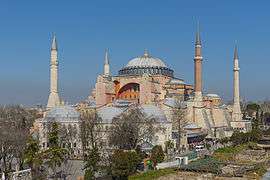 Hagia Sophia, Istanbul | |
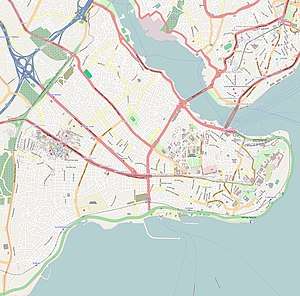 Location in the Fatih district of Istanbul | |
| Location | Fatih, Istanbul, Turkey |
|---|---|
| Designer | Isidore of Miletus Anthemius of Tralles |
| Type |
|
| Material | ashlar, Roman brick |
| Length | 82 m (269 ft) |
| Width | 73 m (240 ft) |
| Height | 55 m (180 ft) |
| Beginning date | 360 |
| Completion date | 537 |
| Dedicated to | Wisdom of God, in reference to the Logos, the second person of the Holy Trinity[1] |
| Website | muze www |
| Part of | Historic Areas of Istanbul |
| Criteria | Cultural: i, ii, iii, iv |
| Reference | 356 |
| Inscription | 1985 (9th session) |
.jpg)
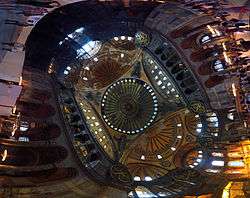
.jpg)
Built by the eastern Roman emperor Justinian I as the Christian cathedral of Constantinople for the state church of the Roman Empire between 532 and 537, the church was then the world's largest interior space and among the first to employ a fully pendentive dome. It is considered the epitome of Byzantine architecture[4] and is said to have "changed the history of architecture".[5] The building was designed by the Greek geometers Isidore of Miletus and Anthemius of Tralles.[6] The present Justinianic building was the third church of the same name to occupy the site, the prior one having been destroyed in the Nika riots. Being the episcopal see of the ecumenical patriarch of Constantinople, it remained the world's largest cathedral for nearly a thousand years, until Seville Cathedral was completed in 1520. Beginning with subsequent Byzantine architecture, Hagia Sophia became the paradigmatic Orthodox church form and its architectural style was emulated by Ottoman mosques a thousand years later.[7] It has been described as "holding a unique position in the Christian world",[7] and architectural and cultural icon of Byzantine and Eastern Orthodox civilization.[8][9][10][7]
The church was dedicated to the Holy Wisdom, the Logos, the second person of the Trinity.[11] Its patronal feast falls on 25 December (Christmas), the commemoration of the incarnation of the Logos in Christ.[11] Sophia is the Latin transliteration of the Greek word for wisdom and, although sometimes referred to as Sancta Sophia, 'Saint Sophia', it is not connected with Sophia the Martyr.[12][13] The centre of the Eastern Orthodox Church for nearly one thousand years, the building witnessed the excommunication of Patriarch Michael I Cerularius officially delivered by Humbert of Silva Candida, the papal envoy of Pope Leo IX in 1054, an act that is commonly considered the start of the East–West Schism. In 1204, it was converted by the Fourth Crusaders to a Roman Catholic cathedral under the Latin Empire, before being restored to the Eastern Orthodox Church upon the return of the Byzantine Empire in 1261. The doge of Venice who led the Fourth Crusade and the 1204 Sack of Constantinople, Enrico Dandolo, was buried in the church.
After the Fall of Constantinople to the Ottoman Empire in 1453,[14] it was converted to a mosque by Mehmed the Conqueror. The patriarchate moved to the Church of the Holy Apostles, which became the city's cathedral. Although some parts of the city had fallen into disrepair, the cathedral had been maintained with funds set aside for this purpose, and the Christian cathedral made a strong impression on the new Ottoman rulers who conceived its conversion.[15][16] The bells, altar, iconostasis, ambo and baptistery were removed and relics destroyed. The mosaics depicting Jesus, his mother Mary, Christian saints, and angels were eventually destroyed or plastered over.[17] Islamic architectural features were added, such as a minbar (pulpit), four minarets, and a mihrab – a niche indicating the direction of prayer (qibla). From its initial conversion until the construction in 1616 of the nearby Sultan Ahmed Mosque, aka the Blue Mosque, it was the principal mosque of Istanbul. The Byzantine architecture of the Hagia Sophia served as inspiration for many other religious buildings from the Hagia Sophia, Thessaloniki and Panagia Ekatontapiliani to the Blue Mosque, the Şehzade Mosque, the Süleymaniye Mosque, the Rüstem Pasha Mosque and the Kılıç Ali Pasha Complex.
The complex remained a mosque until 1931, when it was closed to the public for four years. It was re-opened in 1935 as a museum by the secular Republic of Turkey.[18] According to data released by the Ministry of Culture and Tourism, Hagia Sophia was Turkey's most visited tourist attraction in 2015[19] and 2019.[20][21]
In early July 2020, the Council of State annulled the Cabinet's 1934 decision to establish the museum, revoking the monument's status, and a subsequent decree by Turkish president Recep Tayyip Erdoğan ordered the reclassification of Hagia Sophia as a mosque.[22][23][24] The 1934 decree was ruled to be unlawful under both Ottoman and Turkish law as Hagia Sophia's waqf, endowed by Sultan Mehmed, had designated the site a mosque; proponents of the decision argued the Hagia Sophia was the personal property of the sultan.[25][26][27] This redesignation is controversial, invoking condemnation from the Turkish opposition, UNESCO, the World Council of Churches, the International Association of Byzantine Studies, and many international leaders.[28][29][30][31][32]
History
Church of Constantius II
The first church on the site was known as the Magna Ecclesia (Μεγάλη Ἐκκλησία, Megálē Ekklēsíā, 'Great Church'),[33][34] because of its larger dimensions in comparison to the contemporary churches in the city.[11] According to the Chronicon Paschale, the church was consecrated on 15 February 360, during the reign of the emperor Constantius II (r. 337–361), by the Arian bishop Eudoxius of Antioch,[35][36] it was built next to the area where the Great Palace was being developed. According to the 5th-century ecclesiastical historian Socrates of Constantinople, the emperor Constantius had around 346 "constructed the Great Church alongside that called Irene which because it was too small, the emperor's father [Constantine] had enlarged and beautified".[37][35] A tradition which is not older than the 7th or 8th century, reports that the edifice was built by Constantius' father, Constantine the Great (r. 306–337).[35] Hesychius of Miletus wrote that Constantine built Hagia Sophia with a wooden roof, and removed 427 (mostly pagan) statues from the site.[38] The 12th century chronicler Joannes Zonaras reconciles the two opinions, writing that Constantius had repaired the edifice consecrated by Eusebius of Nicomedia, after it had collapsed.[35] Since Eusebius was bishop of Constantinople 339 to 341, and Constantine died in 337, it seems that the first church was erected by Constantius.[35]
The nearby Hagia Irene ("Holy Peace") church was completed earlier and served as cathedral until the Great Church was completed. Besides Hagia Irene, there is no record of any major churches in the city-centre before the late 4th century.[36] Rowland Mainstone argued the 4th-century church was not yet known as Hagia Sophia.[39] Though its name as the 'Great Church' implies it was larger than other Constantinopolitan churches, the only other major churches of the 4th century were the Church of St Mocius, which lay outside the Constantinian walls and was perhaps attached to a cemetery, and the Church of the Holy Apostles.[36]
The church itself is known to have had a timber roof, curtains, columns, and an entrance that faced west.[36] It probably had a narthex, and is described as being shaped like a Roman circus.[40] This may mean that it had a U-shaped plan like the basilicas of San Marcellino e Pietro and Sant'Agnese fuori le mura in Rome.[36] However, it may also have been a more conventional three-, four-, or five-aisled basilica, perhaps resembling the original Church of the Holy Sepulchre in Jerusalem or the Church of the Nativity in Bethlehem.[36] The building was likely preceded by an atrium, as in the later churches on the site.
According to Ken Dark and Jan Kostenec, a further remnant of the 4th century basilica may exist in a wall of alternating brick and stone banded masonry immediately to the west of the Justinianic church.[41] The top part of the wall is constructed with bricks stamped with brick-stamps dating from the 5th century, but the lower part is of constructed of bricks typical of the 4th century.[41] This wall was probably part of the propylaeum at the west front of both the Constantinian and Theodosian Great Church.[41]
The building was accompanied by a baptistery and a skeuophylakion.[36] A hypogeum, perhaps with an martyrium above it, was discovered before 1946 and the surviving parts of a brick wall with traces of marble revetment were identified in 2004.[41] The hypogeum was a tomb which may have been part of the 4th-century church or may have dated from the pre-Constantinian city of Byzantium.[41] The skeuophylakion is said by Palladius to have circular plan, and because some U-shaped basilicas in Rome were funerary churches with attached circular mausolea (the Mausoleum of Constantina and the Mausoleum of Helena) it is possible it originally had a funerary function, though by 405 its use had changed.[41] One much later account credited a woman called Anna with donating the land on which the church was built in return for the right to be buried there.[41]
Excavations on the western side of the site of the first church under the propylaeum wall reveal that the first church was built atop a road some 8 metres (26 ft) broad.[41] According to early accounts, the first Hagia Sophia was built on the site of an ancient pagan temple,[42][43][44] although there are no artefacts to confirm this.[45]
The Patriarch of Constantinople John Chrysostom came into a conflict with Empress Aelia Eudoxia, wife of the emperor Arcadius (r. 395–408), and was sent into exile on 20 June 404. During the subsequent riots, this first church was largely burnt down.[35] Palladius noted that the 4th-century skeuophylakion survived the fire.[46] According to Dark and Kostenec, the fire may only have affected the main basilica, leaving the surrounding ancillary buildings intact.[46]
Church of Theodosius II
A second church on the site was ordered by Theodosius II (r. 401–450), who inaugurated it on 10 October 415. The Notitia Urbis Constantinopolitanae describes the Hagia Sophia as the Magna Ecclesia, 'Great Church', while the former cathedral Hagia Irene is named the Ecclesia Antiqua, 'Old Church'. At the time of Socrates of Constantinople around 440, "both churches are enclosed by a single wall and served by the same clergy".[37] The complex would thus have encompassed a large area including the site of the later Hospital of Samson.[46] If the fire of 404 destroyed only the 4th-century main basilica church, then the 5th century Theodosian basilica could have been built surrounded by a mainly 4th-century complex.[46]
The area of the western entrance to the Justinianic Hagia Sophia revealed the western remains of its Theodosian predecessor, as well as some fragments of the Constantinian church.[46] German archaeologist Alfons Maria Schneider began conducting archaeological excavations during the mid-1930s, publishing his final report in 1941.[46] Excavations in the area that had once been the 6th-century atrium of the Justinianic church revealed the monumental western entrance and atrium, along with columns and sculptural fragments from both 4th- and 5th-century churches.[46] Further digging was abandoned for fear of impinging on the integrity of the Justinianic building, but parts of the excavation trenches remain uncovered, laying bare the foundations of the Theodosian building.
The basilica was built by architect Rufinus. The church's main entrance faced west, perhaps with gilded doors, and with an additional entrance to the east.[47] There was a central pulpit, and probably there was an upper gallery, possibly employed as a matroneum (women's section).[47] The exterior was decorated with elaborate carvings with rich Theodosian-era designs, of which fragments survive, while the floor just inside the portico was embellished with polychrome mosaics.[46] The surviving carved gable end from the centre of the western facade is decorated with a cross-roundel.[46] Fragments of a frieze of reliefs with 12 lambs representing the 12 apostles also remain; unlike Justinian's 6th-century church the Theodosian Hagia Sophia had both colourful floor mosaics and external decorative sculpture.[46]
At the western end, surviving stone fragments of the show there was vaulting, at least at the western end.[46] The Theodosian building had a monumental propylaeum hall with a portico, which may account for this vaulting, which was thought by the original excavators in the 1930s to be part of the western entrance of the church itself.[46] The propylaeum opened onto an atrium which lay in front of the basilica church itself. Preceding the propylaeum was a steep monumental staircase following the contours of the ground as it sloped away westwards in the direction of the Strategion, the Basilica, and the harbours of the Golden Horn.[46] This arrangement would have recalled the steps outside the atrium of the Constantinian Old St Peter's Basilica in Rome.[46] Nearby was a cistern, perhaps to supply a fountain in the atrium or for worshippers to wash with before entering.[46]
The 4th-century skeuophylakion was replaced in the 5th century by the present-day structure, a rotunda constructed of banded masonry in the lower two levels and of plain brick masonry in the third.[46] Originally this rotunda, probably employed as a treasury for liturgical objects, had a second-storey internal gallery accessed by an external spiral staircase and two levels of niches for storage.[46] A further row, of windows with marble window frames on the third level remain bricked up.[46] The gallery was supported on monumental consoles with carved acanthus designs, similar to those used on the late 5th-century Column of Leo.[46] A large lintel of the skeuophylakion's western entrance – bricked up in the Ottoman era – was discovered inside the rotunda when it was archaeologically cleared to its foundations in 1979, during which time the brickwork was also repointed.[46] The skeuophylakion was again restored in 2014 by the Vakıflar.[46]
A fire started during the tumult of the Nika Revolt, which had begun nearby in the Hippodrome of Constantinople, and the second Hagia Sophia was burnt to the ground on 13–14 January 532. The court historian Procopius wrote:[48]
And by way of shewing that it was not against the Emperor alone that they [the rioters] had taken up arms, but no less against God himself, unholy wretches that they were, they had the hardihood to fire the Church of the Christians, which the people of Byzantium call "Sophia", an epithet which they have most appropriately invented for God, by which they call His temple; and God permitted them to accomplish this impiety, foreseeing into what an object of beauty this shrine was destined to be transformed. So the whole church at that time lay a charred mass of ruins.
— Procopius, De aedificiis, I.1.21–22
- Remains of the Theodosian Hagia Sophia
 Column and capital with a Greek cross
Column and capital with a Greek cross Porphyry column; column capital; impost block
Porphyry column; column capital; impost block Soffits and cornice
Soffits and cornice- Columns and other fragments
 Frieze with lambs
Frieze with lambs Frieze with lambs
Frieze with lambs Theodosian capital for a pilaster
Theodosian capital for a pilaster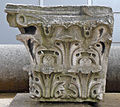 Theodosian capital
Theodosian capital- Theodosian capital for a column

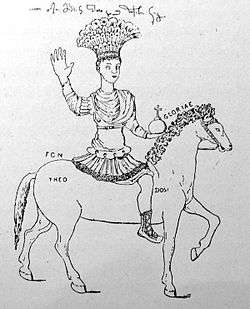
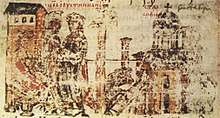
Church of Justinian I (current structure)
On 23 February 532, only a few weeks after the destruction of the second basilica, Emperor Justinian I decided to build a third and entirely different basilica, larger and more majestic than its predecessors. It was designed by Anthemius of Tralles, and Isidore of Miletus.
Construction of the church began in 532 during the short term of Phocas as praetorian prefect.[49] Phocas replaced John the Cappadocian after the Nika Riots saw the destruction of the Theodosian church, although he had previously been arrrested in 529 on suspicion of paganism.[49] According to John the Lydian, Phocas was responsible for funding the initial construction of the building with 4,000 Roman pounds of gold, although he was dismissed from office in October 532.[50][49] John the Lydian, writing in the 550s, was careful to say Phocas had acquired the funds by moral means; Evagrius Scholasticus later wrote that he had obtained the money unjustly.[51][49]
According to Anthony Kaldellis, both of Hagia Sophia's architects named by Procopius were associated with to the school of the pagan philosopher Ammonius of Alexandria.[49] It is possible that both they and John the Lydian envisaged Hagia Sophia as a great temple of the supreme Neoplantonist deity whose visible manifestation was light and the sun. John the Lydian describes the church as the "temenos of the Great God" (Greek: τὸ τοῦ μεγάλου θεοῦ Τέμενος, romanized: tò toû meglou theoû Témenos).[50][49]
Originally the exterior was covered with marble veneer, as indicated by remaining pieces of marble and surviving attachments for lost panels on the building's western face.[52] The white marble cladding of much of the church, together with gilding of some parts, would have given Hagia Sophia a shimmering appearance quite different to the brick- and plaster-work of the modern period, and would greatly have increased its visibility from the sea.[52] The cathedral's interior surfaces were sheathed with polychrome marbles, green and white with purple porphyry, and gold mosaics. The exterior was clad in stucco tinted yellow and red during restorations in the 19th century at the direction of the Fossati architects.
Justinian chose geometer and engineer Isidore of Miletus and mathematician Anthemius of Tralles as architects. The construction is described by Procopius's On Buildings (Greek: Περὶ κτισμάτων, romanized: Peri ktismatōn, Latin: De aedificiis).[48] Columns and other marbles were brought from all over the empire, throughout the Mediterranean. The idea of these columns being spoils from cities such as Rome and Ephesus is a later invention.[53] Even though they were made specifically for Hagia Sophia, the columns show variations in size.[54] More than ten thousand people were employed. This new church was contemporaneously recognized as a major work of architecture. Outside the church was an elaborate array of monuments around the bronze-plated Column of Justinian, topped by an equestrian statue of the emperor which dominated the Augustaeum, the open square outside the church which connected it with the Great Palace complex through the Chalke Gate. At the edge of the Augustaeum was the Milion and the Regia, the first stretch of Constantinople's main thoroughfare, the Mese. Also facing the Augustaeum were the enormous Constantinian thermae, the Baths of Zeuxippus, and the Justinianic civic basilica under which was the vast cistern known as the Basilica Cistern. On the opposite side of Hagia Sophia was the former cathedral, Hagia Irene.
Referring to the destruction of the Theodosian Hagia Sophia and comparing the new church with the old, Procopius lauded the Justinianic building, writing in De aedificiis:[48]
... the Emperor Justinian built not long afterwards a church so finely shaped, that if anyone had enquired of the Christians before the burning if it would be their wish that the church should be destroyed and one like this should take its place, shewing them some sort of model of the building we now see, it seems to me that they would have prayed that they might see their church destroyed forthwith, in order that the building might be converted into its present form.
— Procopius, De aedificiis, I.1.22–23
The Justinian and Patriarch Menas, inaugurated the new basilica on 27 December 537 – 5 years and 10 months after construction started – with much pomp.[55][56][57] Hagia Sophia was the seat of the Patriarchate of Constantinople and a principal setting for Byzantine imperial ceremonies, such as coronations. Like other churches throughout Christendom, the basilica offered sanctuary from persecution to outlaws.
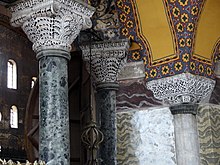
Earthquakes in August 553 and on 14 December 557 caused cracks in the main dome and eastern semi-dome. According to the Chronicle of John Malalas, during a subsequent earthquake on 7 May 558,[58] the eastern semi-dome fell down, destroying the ambon, altar, and ciborium. The collapse was due mainly to the unfeasibly high bearing load and to the enormous shear load of the dome, which was too flat.[55] These caused the deformation of the piers which sustained the dome.[55] Justinian ordered an immediate restoration. He entrusted it to Isidorus the Younger, nephew of Isidore of Miletus, who used lighter materials. The entire vault had to be taken down and rebuilt 20 Byzantine feet (6.25 meters or 20.5 feet) higher than before, giving the building its current interior height of 55.6 meters (182 ft).[59] Moreover, Isidorus changed the dome type, erecting a ribbed dome with pendentives whose diameter was between 32.7 and 33.5 m.[55] Under Justinian's orders, eight Corinthian columns were disassembled from Baalbek, Lebanon, and shipped to Constantinople around 560.[60] This reconstruction, giving the church its present 6th-century form, was completed in 562. The poet Paul the Silentiary composed a long Greek poem, an ekphrasis, for the re-dedication of the basilica presided over by Patriarch Eutychius on 23 December 562. Paul the Silentiary's poem is conventionally known under the Latin title Descriptio Sanctae Sophiae, and he was also author of another ekphrasis on the ambon of the church, the Descripto Ambonis.[61][62] The mosaics were completed in the reign of Emperor Justin II (r. 565–578), Justinian I's successor.
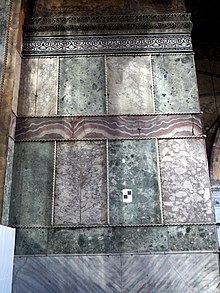
In 726, the emperor Leo the Isaurian issued a series of edicts against the veneration of images, ordering the army to destroy all icons – ushering in the period of Byzantine iconoclasm. At that time, all religious pictures and statues were removed from the Hagia Sophia. After a brief reprieve under Empress Irene (797–802), the iconoclasts made a comeback. The Emperor Theophilus (r. 829–842) had two-winged bronze doors with his monograms installed at the southern entrance of the church.
The basilica suffered damage, first in a great fire in 859, and again in an earthquake on 8 January 869, that made one of the half-domes collapse. Emperor Basil I ordered the church repaired.
In his book De caerimoniis aulae Byzantinae ("Book of Ceremonies"), Emperor Constantine VII (r. 913–959) wrote a detailed account of the ceremonies held in the Hagia Sophia by the emperor and the patriarch.
After the great earthquake of 25 October 989, which collapsed the western dome arch, Emperor Basil II asked for the Armenian architect Trdat, creator of the Cathedral of Ani, to direct the repairs.[63] He erected again and reinforced the fallen dome arch, and rebuilt the west side of the dome with 15 dome ribs.[64] The extent of the damage required six years of repair and reconstruction; the church was re-opened on 13 May 994. At the end of the reconstruction, the church's decorations were renovated, including the addition of four immense paintings of cherubs; a new depiction of Christ on the dome; a burial cloth of Christ shown on Fridays, and on the apse a new depiction of the Virgin Mary holding Jesus, between the apostles Peter and Paul.[65] On the great side arches were painted the prophets and the teachers of the church.[65]
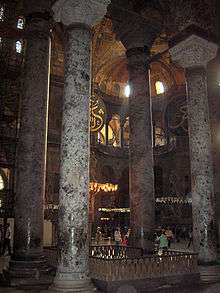
According to the 13th-century Greek historian Niketas Choniates, in 1133 the emperor John II Comnenus celebrated a revived Roman triumph after his victory over the Danishmendids at the siege of Kastamon.[66] After a proceeding through the streets on foot carrying a cross with a silver quadriga bearing the icon of the Virgin Mary, the emperor participated in a ceremony at the cathedral before entering the imperial palace.[67] In 1168, another triumph was held by the emperor Manuel I Comnenus, again preceding with a gilded silver quadriga bearing the icon of the Virgin from the now-demolished East Gate (or Gate of St Barbara, later the Turkish: Top Kapısı, lit. 'Cannon Gate') in the Propontis Wall, to Hagia Sophia for a thanks-giving service, and then to the imperial palace.[68]
In 1181, the daughter of the emperor Manuel I, Maria Comnena and her husband, the caesar Renier of Montferrat, fled to Hagia Sophia at the culmination of their dispute with the empress Maria of Antioch, regent for her son, the emperor Alexius II Comnenus.[69] Maria Comnena and Renier occupied the cathedral with the support of the patriarch, refusing the demands of the imperial administration that they depart peaceably.[69] According to Niketas Choniates, they "transformed the sacred courtyard into a military camp", garrisoned the entrances to the complex with locals and mercenaries, and despite the strong opposition of the patriarch, made the "house of prayer into a den of thieves or a well-fortified and precipitous stronghold, impregnable to assault", while "all the dwellings adjacent to Hagia Sophia and adjoining the Augusteion were demolished by her men".[69] A battle ensued in the Augustaion and around the Milion, during which the defenders fought from the "gallery of the Catechumeneia (also called the Makron)" facing the Augusteion, from which they eventually retreated and took up positions in the exonarthex of Hagia Sophia itself.[69] At this point, "the patriarch was anxious lest the enemy troops enter the temple, with unholy feet trample the holy floor, and with hands defiled and dripping with blood still warm plunder the all-holy dedicatory offerings".[69] After a successful sally by Renier and his knights, Maria asked for a truce, the imperial assault ceased, and an amnesty was negotiated by the megas doux Andronikos Kontostephanos and the megas hetaireiarches, John Doukas.[70] Niketas Choniates compared the preservation of the cathedral to the efforts made by the 1st-century emperor Titus to avoid the destruction of the Second Temple during the Siege of Jerusalem in the First Jewish–Roman War.[70] Niketas Choniates reports that in 1182, a white hawk wearing jesses was seen to fly from the east to Hagia Sophia, flying three times from the "building of the Thōmaitēs" (a basilica erected on the southeastern side of the Augustaion) to the Palace of the Kathisma in the Great Palace, where new emperors were acclaimed.[71] This was supposed to presage the end of the reign of Andronicus I Comnenus (r. 1183–1185).[71]
According to the Greek historian Niketas Choniates, in 1203 during the Fourth Crusade, the emperors Isaac II Angelus and Alexius IV Angelus stripped Hagia Sophia of all the gold ornaments and all the silver oil-lamps in order to pay off the Crusaders who had ousted Alexius III Angelus and helped Isaac return to the throne.[72] Upon the subsequent Sack of Constantinople in 1204, the church was further ransacked and desecrated by the Crusaders, as described by Niketas, though he did not witness the events in person. According to his account, composed at the court of the rump Empire of Nicaea, Hagia Sophia was stripped of its remaining metal ornaments, its altar was smashed into pieces, and a "woman laden with sins" sang and danced on the synthronon.[73][74][75] He adds that mules and donkeys were brought into the cathedral's sanctuary to carry away the gilded silver plating of the bema, the ambo, and the doors and other furnishings, and that one of these slipped on the marble floor and was accidentally disembowelled, further contaminating the place.[73] According to Ali ibn al-Athir, whose treatment of the Sack of Constantinople was probably dependent on a Christian source, the Crusaders massacred some clerics who had surrendered to them.[76] Much of the interior was damaged and would not be repaired until its return to Orthodox control in 1261.[45] The sack of Hagia Sophia, and Constantinople in general, remained a sore point in Catholic–Eastern Orthodox relations.[77]
During the Latin occupation of Constantinople (1204–1261) the church became a Roman Catholic cathedral. Baldwin I of Constantinople (r. 1204–1205) was crowned emperor on 16 May 1204 in Hagia Sophia, at a ceremony which closely followed Byzantine practices. Enrico Dandolo, the Doge of Venice who commanded the sack and invasion of the city by the Latin Crusaders in 1204, is buried inside the church, probably in the upper eastern gallery. In the 19th century, an Italian restoration team placed a cenotaph marker, frequently mistaken as being a medieval, near the probable location and still visible today. The original tomb was destroyed by the Ottomans during the conversion of the church into a mosque.[78]
At the capture of Constantinople in 1261 by the Empire of Nicaea and the emperor Michael VIII Palaeologus, (r. 1261–1282) the church was in a dilapidated state. In 1317, emperor Andronicus II Palaeologus (r. 1282–1328) ordered four new buttresses (Byzantine Greek: Πυραμίδας, romanized: Pyramídas) to be built in the eastern and northern parts of the church, financing them with the inheritance of his late wife, Irene of Montferrat (d.1314).[17] New cracks developed in the dome after the earthquake of October 1344, and several parts of the building collapsed on 19 May 1346; consequently, the church was closed until 1354, when repairs were undertaken by architects Astras and Peralta.
On 12 December 1452, Isidore of Kiev proclaimed in Hagia Sophia the long-anticipated and short-lived ecclesiastical union between the western Catholic and eastern Orthodox Churches as decided at the Council of Florence and the papal bull Laetentur Caeli. The union was unpopular among the Byzantines, who had already expelled the Partiarch of Constantinople, Gregory III, for his pro-union stance. A new patriarch was not installed until after the Ottoman conquest. According to the Greek historian Doukas, the Hagia Sophia was tainted by these Catholic associations, and the anti-union Orthodox faithful avoided the cathedral, considering it to be a haunt of demons and a "Hellenic" temple of Roman paganism.[79]
.jpg)
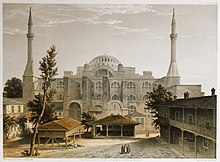
According to Nestor Iskander's Tale on the Taking of Tsargrad, the Hagia Sophia was the focus of an alarming omen interpreted as the Holy Spirit abandoning Constantinople on 21 May 1453, in the final days of the Siege of Constantinople.[80] The sky lit up, illuminating the city, and "many people gathered and saw on the Church of the Wisdom, at the top of the window, a large flame of fire issuing forth. It encircled the entire neck of the church for a long time. The flame gathered into one; its flame altered, and there was an indescribable light. At once it took to the sky. ... The light itself has gone up to heaven; the gates of heaven were opened; the light was received; and again they were closed."[80] This phenomenon was perhaps St Elmo's fire induced by gunpowder smoke and unusual weather.[80] In Niccolò Barbaro's account, the statue on the Column of Justinian in the Augustaion beside Hagia Sophia, which gestured towards Asia, was interpreted in the last days of the siege as indicating "this is the way my conqueror will come".[80]
Mosque (1453–1935)
Constantinople fell to the attacking Ottoman forces on 29 May 1453. Sultan Mehmed entered the city and performed the Friday prayer and kutbah (sermon) in Hagia Sophia, this action marked the official conversion of Hagia Sophia into a mosque.[81]
In accordance with the traditional custom at the time, Sultan Mehmed II allowed his troops and his entourage three full days of unbridled pillage and looting in the city shortly after it was captured. Once the three days passed, he would then claim its remaining contents for himself.[82][83] According to the Encyclopædia Britannica Mehmed II "permitted an initial period of looting that saw the destruction of many Orthodox churches".[84] However, by the end of the first day, he proclaimed that the looting should cease as he felt profound sadness when he toured the looted and enslaved city.[85][82]
Hagia Sophia was not exempted from the pillage and looting and specifically became its focal point as the invaders believed it to contain the greatest treasures and valuables of the city.[86] Shortly after the defence of the Walls of Constantinople collapsed and the Ottoman troops entered the city victoriously, the pillagers and looters made their way to the Hagia Sophia and battered down its doors before storming in.[87]
Throughout the period of the siege of Constantinople, the trapped worshippers of the city participated in the Divine Liturgy and the Prayer of the Hours at the Hagia Sophia and the church formed a safe-haven and a refuge for many of those who were unable to contribute to the city's defence, which comprised women, children, elderly, the sick and the wounded.[88][89] Being trapped in the church, the many congregants and yet more refugees inside became spoils-of-war to be divided amongst the triumphant invaders. The building was desecrated and looted, with the helpless occupants who sought shelter within the church being enslaved.[86] While most of the elderly and the infirm/wounded and sick were killed, and the remainder (mainly teenage males and young boys) were chained up and sold into slavery.[90]
The church's priests and religious personnel continued to perform Christian rites, prayers and ceremonies until finally being forced to stop by the invaders.[90] When Sultan Mehmed and his entourage entered the church, he ordered that it be converted into a mosque at once. One of the ʿulamāʾ (Islamic scholars) present climbed onto the church's ambo and recited the shahada ("There is no god but God, and Muhammed is his messenger"), thus marking the beginning of the conversion of the church into a mosque.[17][91] Mehmed is reported to have taken a sword to a soldier who tried to prise up one of the paving slabs of the Proconnesian marble floor.[92]
.jpg)
As described by Western visitors before 1453, such as the Córdoban nobleman Pero Tafur[93] and the Florentine geographer Cristoforo Buondelmonti,[94] the church was in a dilapidated state, with several of its doors fallen from their hinges; Mehmed II ordered a renovation of the building. Mehmed attended the first Friday prayer in the mosque on 1 June 1453.[95] Aya Sofya became the first imperial mosque of Istanbul.[96] To the corresponding waqf were endowed most of the existing houses in the city and the area of the future Topkapı Palace.[17] From 1478, 2,360 shops, 1,300 houses, 4 caravanserais, 30 boza shops, and 23 shops of sheep heads and trotters gave their income to the foundation.[97] Through the imperial charters of 1520 (AH 926) and 1547 (AH 954) shops and parts of the Grand Bazaar and other markets were added to the foundation.[17]
Before 1481, a small minaret was erected on the southwest corner of the building, above the stair tower.[17] Later, Mehmed's successor Bayezid II (r. 1481–1512) built another minaret at the northeast corner.[17] One of these collapsed after the earthquake of 1509,[17] and around the middle of the 16th century they were both replaced by two diagonally opposite minarets built at the east and west corners of the edifice.[17] In 1498, Bernardo Bonsignori was the last Western visitor to Hagia Sophia to report seeing the ancient Justinianic floor; shortly afterwards the floor was covered over with carpet and not seen again until the 19th-century.[92]
In the 16th century, Sultan Suleiman the Magnificent (r. 1520–1566) brought two colossal candlesticks from his conquest of the Kingdom of Hungary and placed them on either side of the mihrab. During Suleiman's reign, the mosaics above the narthex and imperial gates depicting Jesus, Mary and various Byzantine emperors were covered by whitewash and plaster, which was removed in 1930 under the Turkish Republic.[98]
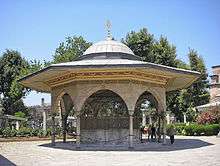
.jpg)
During the reign of Selim II (r. 1566–1574), the building started showing signs of fatigue and was extensively strengthened with the addition of structural supports to its exterior by Ottoman architect Mimar Sinan, who was also an earthquake engineer.[99] In addition to strengthening the historic Byzantine structure, Sinan built the two additional large minarets at the western end of the building, the original sultan's lodge and the türbe (mausoleum) of Selim II to the southeast of the building in 1576–1577 / AH 984. In order to do that, parts of the Patriarchate at the south corner of the building were pulled down the previous year.[17] Moreover, the golden crescent was mounted on the top of the dome,[17] while a respect zone 35 arşin (about 24 m) wide was imposed around the building, pulling down all the houses which in the meantime had nested around it.[17] Later his türbe hosted also 43 tombs of Ottoman princes.[17] Murad III (r. 1574–1595) had two large alabaster Hellenistic urns transported from Pergamon (Bergama) and placed on two sides of the nave.[17]
In 1594 / AH 1004 Mimar (court architect) Davud Ağa built the türbe of Murad III, where the Sultan and his valide, Safiye Sultan were later buried.[17] The octagonal mausoleum of their son Mehmed III (r. 1595–1603) and his valide was built next to it in 1608 (AH 1017) by royal architect Dalgiç Mehmet Aĝa.[100] His son Mustafa I (r. 1617–1618, 1622–1623) converted the baptistery into his türbe.[100]
In 1717, under Sultan Ahmed III (r. 1703–1730), the crumbling plaster of the interior was renovated, contributing indirectly to the preservation of many mosaics, which otherwise would have been destroyed by mosque workers.[100] In fact, it was usual for them to sell the mosaic's tesserae—believed to be talismans—to the visitors.[100] Sultan Mahmud I ordered the restoration of the building in 1739 and added a medrese (a Koranic school, subsequently the library of the museum), an imaret (soup kitchen for distribution to the poor) and a library, and in 1740 a Şadirvan (fountain for ritual ablutions), thus transforming it into a külliye, i.e. a social complex. At the same time, a new sultan's lodge and a new mihrab were built inside.
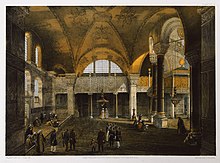
Renovation of 1847–49
Restoration of the Hagia Sophia was ordered by Sultan Abdulmejid I (r. 1823–1861) and completed by eight hundred workers between 1847 and 1849, under the supervision of the Swiss-Italian architect brothers Gaspare and Giuseppe Fossati. The brothers consolidated the dome with a restraining iron chain and strengthened the vaults, straightened the columns, and revised the decoration of the exterior and the interior of the building.[101] The mosaics in the upper gallery were exposed and cleaned, although many were recovered "for protection against further damage".
Eight new gigantic circular-framed discs or medallions were hung from the cornice, on each of the four piers and at either side of the apse and the west doors. These were painted, to designs by the calligrapher Kazasker Mustafa Izzet Efendi (1801–1877), with the names of Allah, Muhammad, the Rashidun (the first four caliphs: Abu Bakr, Umar, Uthman and Ali), and the two grandsons of Muhammad: Hasan and Husayn, the sons of Ali. The old chandeliers were replaced by new pendant ones.
In 1850 the architects Fossati built a new maqsura or caliphal loge in Neo-Byzantine columns and an Ottoman–Rococo style marble grille, connecting to the royal pavilion behind the mosque.[101] The new maqsura was built at the extreme east end of the northern aisle, next to the north-eastern pier. The existing maqsura in the apse, near the mihrab, was demolished.[101] A new entrance was constructed for the sultan: the Hünkar Mahfili.[101] The Fossati brothers also renovated the minbar and mihrab.
Outside the main building, the minarets were repaired and altered so that they were of equal height.[102] A clock building, the Muvakkithanesi was built by the Fossatis for the use of the muwaqqit (the mosque timekeeper), and a new madrasa (Islamic school) was constructed. The Kasr-ı Hümayun was also built under their direction.[101] When the restoration was finished, the mosque was re-opened with ceremonial pomp on 13 July 1849. An edition of lithographs from drawings made during the Fossatis' work on Hagia Sophia was published in London in 1852, entitled: Aya Sophia of Constantinople as Recently Restored by Order of H.M. The Sultan Abdulmedjid.[101]
- Gaspare Fossati's Hagia Sophia (lithographs by Louis Haghe)
 Nave before restoration, looking east.
Nave before restoration, looking east. Nave and apse after restoration, looking east.
Nave and apse after restoration, looking east..jpg) Nave and entrance after restoration, looking west.
Nave and entrance after restoration, looking west. Narthex, looking north.
Narthex, looking north. Exonarthex, looking north
Exonarthex, looking north North aisle from the entrance looking east
North aisle from the entrance looking east North aisle, looking west.
North aisle, looking west. Nave and south aisle from the north aisle.
Nave and south aisle from the north aisle. Northern gallery and entrance to the matroneum from the north-west.
Northern gallery and entrance to the matroneum from the north-west. Southern gallery from the south-west
Southern gallery from the south-west Southern gallery from the Marble Door looking west.
Southern gallery from the Marble Door looking west. Southern gallery from the Marble Door looking east.
Southern gallery from the Marble Door looking east.
Museum (1935–2020)
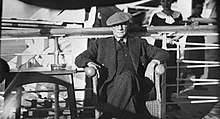
In 1935, the first Turkish President and founder of the Republic of Turkey, Mustafa Kemal Atatürk, transformed the building into a museum. The carpet and the layer of mortar underneath them were removed and marble floor decorations such as the omphalion appeared for the first time since the Fossatis' restoration,[103] while the white plaster covering many of the mosaics was removed. Nevertheless, the condition of the structure deteriorated, and the World Monuments Fund (WMF) placed Hagia Sophia on 1996 World Monuments Watch, and again in 1998. The building's copper roof had cracked, causing water to leak down over the fragile frescoes and mosaics. Moisture entered from below as well. Rising ground water had raised the level of humidity within the monument, creating an unstable environment for stone and paint. The WMF secured a series of grants from 1997 to 2002 for the restoration of the dome. The first stage of work involved the structural stabilization and repair of the cracked roof, which was undertaken with the participation of the Turkish Ministry of Culture. The second phase, the preservation of the dome's interior, afforded the opportunity to employ and train young Turkish conservators in the care of mosaics. By 2006, the WMF project was complete, though many other areas of Hagia Sophia continue to require significant stability improvement, restoration and conservation.[104]
In 2014, Hagia Sophia was the second most visited museum in Turkey, attracting almost 3.3 million visitors annually.[105]
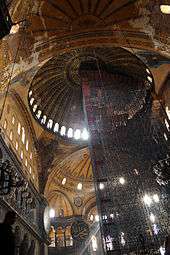
While use of the complex as a place of worship (mosque or church) was strictly prohibited,[106] in 1991 the Turkish government allowed the allocation of a pavilion in the museum complex (Ayasofya Müzesi Hünkar Kasrı'nda) to be used as a prayer room, and since 2013, two of the museum′s minarets had been used for voicing the call to prayer (the ezan) regularly.[107][108]
In 2007, Greek American politician Chris Spirou launched an international organization "Free Agia Sophia Council" championing the cause of restoring the building to its original function as a Christian church.[109][110][111] From the early 2010s, several campaigns and government high officials, notably Turkey's deputy prime minister Bülent Arınç in November 2013, had demanded that Hagia Sophia be converted into a mosque again.[112][113][114] In 2015, in response to the acknowledgement by Pope Francis of the Armenian Genocide, which is officially denied in Turkey, the mufti of Ankara, Mefail Hızlı, said that he believed that the Pope′s remarks would accelerate the conversion of Hagia Sophia into a mosque.[115]
On 1 July 2016, Muslim prayers were held again in the Hagia Sophia for the first time in 85 years.[116] On November, the Turkish non-governmental organization, the Association for the Protection of Historic Monuments and the Environment filed a lawsuit for converting the museum into a mosque.[117] The court decided it should stay as a 'monument museum'.[118] In October 2016, Turkey's Directorate of Religious Affairs (Diyanet) appointed, for the first time in 81 years, a designated imam, Önder Soy, to the Hagia Sofia mosque (Ayasofya Camii Hünkar Kasrı'nda), located at the Hünkâr Kasrı, a pavilion for the sultans' private ablutions. Since then, the adhan has been regularly called out from the Hagia Sophia′s all four minarets five times a day.[107][108][119]
On 13 May 2017 a large group of people, organized by the Anatolia Youth Association (AGD), gathered in front of Hagia Sophia and prayed the morning prayer with a call for the re-conversion of the museum into a mosque.[120] On 21 June 2017 the Directorate of Religious Affairs (Diyanet) organized a special programme, broadcast live by state-run television TRT, which included the recitation of the Quran and prayers in Hagia Sofia, to mark the Laylat al-Qadr.[121]
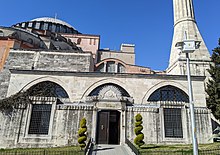
Reversion to mosque (2018–present)
Since 2018, Turkish president Recep Tayyip Erdoğan had spoken of reverting the status of the Hagia Sophia back to a mosque, a move seen to be very popularly accepted by the religious populace whom Erdoğan is attempting to persuade.[122] On 31 March 2018 Erdoğan recited the first verse of the Quran in the Hagia Sophia, dedicating the prayer to the "souls of all who left us this work as inheritance, especially Istanbul's conqueror," strengthening the political movement to make the Hagia Sophia a mosque once again, which would reverse Atatürk's measure of turning the Hagia Sophia into a secular museum.[123] In March 2019 Erdoğan said that he would change the status of Hagia Sophia from a museum to a mosque,[124] adding that it had been a "very big mistake" to turn it into a museum.[125] As a UNESCO World Heritage site, this change would require approval from UNESCO's World Heritage Committee.[126] In late 2019 Erdoğan's office took over the administration and upkeep of the nearby Topkapı Palace Museum, transferring responsibility for the site from the Ministry of Culture and Tourism by presidential decree.[127][128][129]
In 2020, Turkey's government celebrated the 567th anniversary of the Fall of Constantinople with an Islamic prayer in Hagia Sophia. Turkish president Recep Tayyip Erdoğan said during a televised broadcast "Al-Fath surah will be recited and prayers will be done at Hagia Sophia as part of conquest festival".[130] In May, during the anniversary events, passages from the Quran was read in the Hagia Sophia. Greece condemned this action, while Turkey in response accused Greece of making “futile and ineffective statements”.[131] In June, the head of the Turkey's Directorate of Religious Affairs (Diyanet) said that "we would be very happy to open Hagia Sophia for worship" and if this happens "we will provide our religious services as we do in all our mosques”.[117] On 25 June, John Haldon, president of the International Association of Byzantine Studies, wrote an open letter to Erdoğan asking that he "consider the value of keeping the Aya Sofya as a museum".[32]
On 10 July 2020, the decision of the Council of Ministers to transform the Hagia Sophia into a museum was cancelled by the Council of State, decreeing that Hagia Sophia can be used only as a mosque and not “for any other purpose”.[132] Despite secular and global criticism, Erdoğan signed a decree annulling the Hagia Sophia's museum status, reverting it to a mosque.[133][134] The call to prayer was broadcast from the minarets shortly after the announcement of the change and rebroadcast by major Turkish news networks.[134] The Hagia Sophia Museum's social media channels were taken down the same day, with Erdoğan announcing at a press conference that prayers themselves would be held there from 24 July.[134] A presidential spokesperson said it would become a working mosque, open to anyone similar to the Parisian churches Sacré-Cœur and Notre-Dame. The spokesperson also said that the change would not affect the status of the Hagia Sophia as a UNESCO World Heritage site, and that "Christian icons" within it would continue to be protected.[122] Earlier the same day, before the final decision, the Turkish Finance and Treasury Minister Berat Albayrak and the Justice Minister Abdulhamit Gül expressed their expectations of opening the Hagia Sophia to worship for Muslims.[135][136] Mustafa Şentop, Speaker of Turkey's Grand National Assembly, said "a longing in the heart of our nation has ended".[135] A presidential spokesperson claimed that all political parties in Turkey supported Erdoğan's decision;[137] however, the Peoples' Democratic Party had previously released a statement denouncing the decision, saying "decisions on human heritage cannot be made on the basis of political games played by the government".[138] The mayor of Istanbul, Ekrem İmamoğlu, said that he supports the conversion "as long as it benefits Turkey", adding that he always said that Hagia Sophia is a mosque and for him it has remained a mosque since 1453.[139] Ali Babacan attacked the policy of his former ally Erdoğan, saying the Hagia Sophia issue "has come to the agenda now only to cover up other problems".[140] Orhan Pamuk, Turkish novelist and Nobel laureate, publicly denounced the move, saying "Kemal Atatürk changed ... Hagia Sophia from a mosque to a museum, honouring all previous Greek Orthodox and Roman Catholic history, making it as a sign of Turkish modern secularism".[134][141]
On 17 July, Erdoğan announced that the first prayers in the Hagia Sophia would be open to between 1,000 and 1,500 worshippers, and reiterated that the issue was a matter of Turkey's sovereignty and international reaction would not deter him.[142] Turkey invited foreign leaders and officials, including Pope Francis,[143] for the first prayers which was held on Friday on July 24 2020, in the Hagia Sophia.[144]
On 22 July, a turquoise-coloured carpet was laid to prepare the mosque for worshippers; Ali Erbaş, head of the Diyanet, attended its laying.[140] The omphalion was left exposed. Because of the COVID-19 pandemic in Turkey, Erbaş said Hagia Sophia would accommodate up to 1,000 worshippers at a time and asked that they bring "masks, a prayer rug, patience and understanding".[140] The mosque opened for Friday prayers on 24 July, the 97th anniversary of the signature of the Treaty of Lausanne, which after the victory of the Republic in the Turkish War of Independence reversed the territorial losses of the World War I's Treaty of Sèvres.[145][140] White drapes covered the mosaics of the Virgin and Child in the apse.[141] Erbaş, armed with a sword proclaimed during his sermon, "Sultan Mehmet the Conqueror dedicated this magnificent construction to believers to remain a mosque until the Day of Resurrection".[141] Erdoğan and some government ministers attended the midday prayers as many worshippers prayed outside; at one point the security cordon was breached and dozens of people broke through police lines.[141] It is the fourth Byzantine church converted from museum to a mosque during Erdoğan's rule.[146]
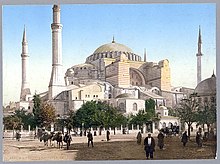
International reaction
Days before the final decision on the conversion was made, Ecumenical Patriarch Bartholomew I of Constantinople stated in a sermon that "the conversion of Hagia Sophia into a mosque would disappoint millions of Christians around the world”, he also said that Hagia Sophia, which was "a vital center where East is embraced with the West", would "fracture these two worlds" in the event of conversion.[147][148] The proposed conversion was decried by other Orthodox Christian leaders, the Russian Orthodox Church's Patriarch Kirill of Moscow stating that "a threat to Hagia Sophia [wa]s a threat to all of Christian civilization".[149][150]
Following the Turkish government′s decision, UNESCO announced it "deeply regret[ed]" the conversion "made without prior discussion", and asked Turkey to "open a dialogue without delay", stating that the lack of negotiation was "regrettable".[28][134] UNESCO further announced that the "state of conservation" of Hagia Sophia would be "examined" at the next session of the World Heritage Committee, urging Turkey "to initiate dialogue without delay, in order to prevent any detrimental effect on the universal value of this exceptional heritage".[28] Ernesto Ottone, UNESCO’s Assistant Director-General for Culture said "It is important to avoid any implementing measure, without prior discussion with UNESCO, that would affect physical access to the site, the structure of the buildings, the site’s moveable property, or the site’s management".[28] UNESCO's statement of 10 July said "these concerns were shared with the Republic of Turkey in several letters, and again yesterday evening with the representative of the Turkish Delegation" without a response.[28]
The World Council of Churches, which claims to represent 500 million Christians of 350 denominations, condemned the decision to convert the building into a mosque, saying that would "inevitably create uncertainties, suspicions and mistrust"; the World Council of Churches urged Turkey′s president Erdoğan "to reconsider and reverse" his decision "in the interests of promoting mutual understanding, respect, dialogue and cooperation, and avoiding cultivating old animosities and divisions".[151][29][152] At the recitation of the Sunday Angelus prayer at St Peter's Square on 12 July Pope Francis said, "My thoughts go to Istanbul. I think of Santa Sophia and I am very pained" (Italian: Penso a Santa Sofia, a Istanbul, e sono molto addolorato).[lower-alpha 1][154][30] The International Association of Byzantine Studies announced that its 21st International Congress, due to be held in Istanbul in 2021, will no longer be held there and is postponed to 2022.[32]
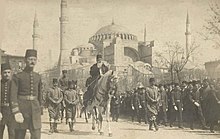
Josep Borrell, the European Union's High Representative for Foreign Affairs and Vice-President of the European Commission, released a statement calling the decisions by the Council of State and Erdoğan "regrettable" and pointing out that "as a founding member of the Alliance of Civilisations, Turkey has committed to the promotion of inter-religious and inter-cultural dialogue and to fostering of tolerance and co-existence."[155] According to Borrell, the European Union member states' twenty-seven foreign ministers "condemned the Turkish decision to convert such an emblematic monument as the Hagia Sophia" at meeting on 13 July, saying it "will inevitably fuel the mistrust, promote renewed division between religious communities and undermine our efforts at dialog and cooperation" and that "there was a broad support to call on the Turkish authorities to urgently reconsider and reverse this decision".[156][157] Greece denounced the conversion and considered it a breach of the UNESCO World Heritage titling.[122] Greek culture minister Lina Mendoni called it an "open provocation to the civilised world" which "absolutely confirms that there is no independent justice" in Erdoğan's Turkey, and that his Turkish nationalism "takes his country back six centuries".[31] Greece and Cyprus called for EU sanctions on Turkey.[158] Morgan Ortagus, the spokesperson for the United States Department of State noted that "We are disappointed by the decision by the government of Turkey to change the status of the Hagia Sophia."[31] Jean-Yves Le Drian, foreign minister of France, said his country "deplores" the move, saying "these decisions cast doubt on one of the most symbolic acts of modern and secular Turkey".[152] Vladimir Dzhabarov, deputy head of the foreign affairs committee of the Russian Federation Council, said that it "will not do anything for the Muslim world. It does not bring nations together, but on the contrary brings them into collision" and calling the move a "mistake".[31] The former deputy prime minister of Italy, Matteo Salvini held a demonstration in protest outside the Turkish consulate in Milan, calling for all plans for accession of Turkey to the European Union to be terminated "once and for all".[159] In East Jerusalem, a protest was held outside the Turkish consulate on the 13 July, with the burning of a Turkish flag and the display of the Greek flag and flag of the Greek Orthodox Church.[160] In a statement the Turkish foreign ministry condemned the burning of the flag, saying "nobody can disrespect or encroach our glorious flag".[161]
Ersin Tatar, prime minister of the Turkish Republic of Northern Cyprus which is recognized only by Turkey, welcomed the decision, calling it "sound" and "pleasing".[162][31] He further criticized the government of Cyprus, claiming that "the Greek Cypriot administration, who burned down our mosques, should not have a say in this".[162] Through a spokesman the Foreign Ministry of Iran welcomed the change, saying the decision was an "issue that should be considered as part of Turkey's national sovereignty" and "Turkey's internal affair".[163] Sergei Vershinin, deputy foreign minister of Russia, said that the matter was of one of "internal affairs, in which, of course, neither we nor others should interfere."[164] The Arab Maghreb Union was supportive.[165] Ekrema Sabri, imam of the al-Aqsa Mosque, and Ahmed bin Hamad al-Khalili, grand mufti of Oman, both congratulated Turkey on the move.[165] The Muslim Brotherhood was also in favour of the news.[165] A spokesman for the Palestinian Islamist movement Hamas called the verdict a "a proud moment for all Muslims".[166] Pakistani politician Chaudhry Pervaiz Elahi of the Pakistan Muslim League (Q) welcomed the ruling, claiming it was "not only in accordance with the wishes of the people of Turkey but the entire Muslim world".[167] The Muslim Judicial Council group in South Africa praised the move, calling it "a historic turning point".[168] In Nouakchott, capital of Mauritania, there were prayers and celebrations topped by the sacrifice of a camel.[169] On the other hand, Shawki Allam, grand mufti of Egypt, ruled that conversion of the Hagia Sophia to a mosque is "impermissible".[170]
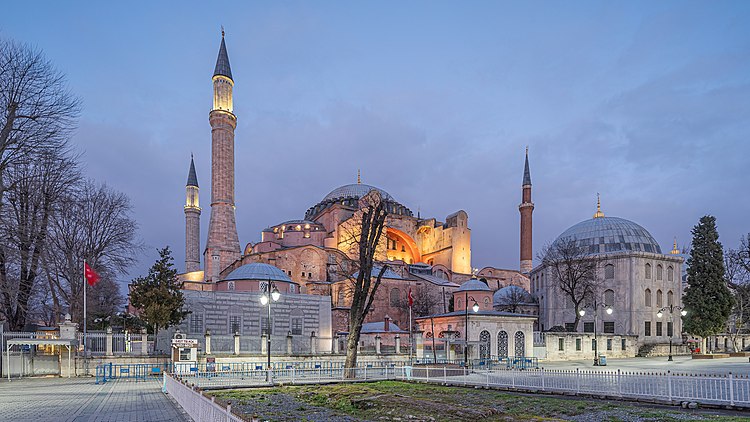
When President Erdoğan announced that the first Muslim prayers would be held inside the building on 24 July, he added that "like all our mosques, the doors of Hagia Sophia will be wide open to locals and foreigners, Muslims and non-Muslims." Presidential spokesman İbrahim Kalın said that the icons and mosaics of the building would be preserved, and that "in regards to the arguments of secularism, religious tolerance and coexistence, there are more than four hundred churches and synagogues open in Turkey today."[171] Ömer Çelik, spokesman for the ruling Justice and Development Party (AKP), announced on 13 July that entry to Hagia Sophia would be free of charge and open to all visitors outside prayer times, during which Christian imagery in the building's mosaics would be covered by curtains or lasers.[159] In response to the criticisms of Pope Francis, Çelik said that the papacy was responsible for the greatest disrespect done to the site, during the 13th-century Roman Catholic Fourth Crusade's sack of Constantinople and the Latin Empire, during which the cathedral was pillaged.[159] The Turkish foreign minister, Mevlüt Çavuşoğlu told TRT Haber on 13 July that the government was surprised at the reaction of UNESCO, saying that "We have to protect our ancestors’ heritage. The function can be this way or that way – it does not matter".[172]
On 14 July the prime minister of Greece, Kyriakos Mitsotakis said his government was "considering its response at all levels" to what he called Turkey's "unnecessary, petty initiative", and that "with this backward action, Turkey is opting to sever links with western world and its values".[173] In relation to both Hagia Sophia and the Cyprus–Turkey maritime zones dispute, Mitsotakis called for European sanctions against Turkey, referring to it as "a regional troublemaker, and which is evolving into a threat to the stability of the whole south-east Mediterranean region".[173] Dora Bakoyannis, Greek former foreign minister, said Turkey's actions had "crossed the Rubicon", distancing itself from the West.[174] On the day of the building's re-opening, Mitsotakis called it not a show of power but evidence of Turkey's weakness.[141]
Architecture
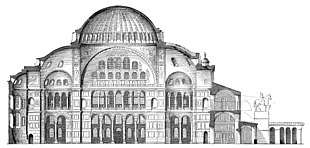

b) Plan of the ground floor (lower half)
Hagia Sophia is one of the greatest surviving examples of Byzantine architecture.[4] Its interior is decorated with mosaics and marble pillars and coverings of great artistic value. The temple itself was so richly and artistically decorated that according to much later legend, Justinian proclaimed, "Solomon, I have outdone thee!" (Byzantine Greek: Νενίκηκά σε Σολομών). Justinian himself had overseen the completion of the greatest cathedral ever built up to that time, and it was to remain the largest cathedral for 1,000 years up until the completion of the cathedral in Seville in Spain.[175]
The Hagia Sophia is of masonry construction. The structure has brick and mortar joints that are 1.5 times the width of the bricks. The mortar joints are composed of a combination of sand and minute ceramic pieces distributed evenly throughout the mortar joints. This combination of sand and potsherds was often used in Roman concrete, predecessor of modern concrete.[176]
Justinian's basilica was at once the culminating architectural achievement of late antiquity and the first masterpiece of Byzantine architecture. Its influence, both architecturally and liturgically, was widespread and enduring in the Eastern Christianity, Western Christianity, and Islam alike.
The vast interior has a complex structure. The nave is covered by a central dome which at its maximum is 55.6 m (182 ft 5 in) from floor level and rests on an arcade of 40 arched windows. Repairs to its structure have left the dome somewhat elliptical, with the diameter varying between 31.24 and 30.86 m (102 ft 6 in and 101 ft 3 in).
At the western entrance side and eastern liturgical side, there are arched openings extended by half domes of identical diameter to the central dome, carried on smaller semi-domed exedrae; a hierarchy of dome-headed elements built up to create a vast oblong interior crowned by the central dome, with a clear span of 76.2 m (250 ft).[4]
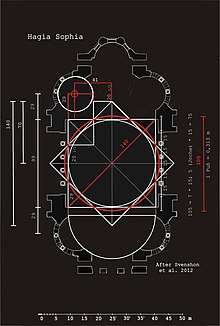
The theories of Hero of Alexandria, a Hellenistic mathematician of the 1st century AD, may have been utilized to address the challenges presented by building such an expansive dome over so large a space.[177] The idea is that , which is not expressible as a rational number, was approximated and deliberately used as a less accurate rational value that approximates the irrational number . This is appropriate for 22/7 which was used for solving circle problems in construction. When it is ascertained that the circle circumference is U=D*22/7, several elegant solutions are produced, among them those which use a diameter which is cancelling the denominator. As thus Svenshon and Stiffel proposed that the architects used Heron's proposed values for constructing vaults. Central for the erection of the dome of the Hagia Sophia was that the central square corresponds to a diagonal, which is expressible as a rational number approximating . If this was not rightly done, all related measures to the square would not be manageable by the instruments of the surveyors of those times. As thus for the calculation of the square measurements derived from the so-called side-and-diagonal number progression were used. With its help, approximations for can be produced, which is essential for measuring all types of square or square-related objects and surfaces (i.e. 1/1, 3/2, 7/5, 17/12, 41/29, 99/70). With this method, the squares defined by the numbers 12 and 17, whereas 12 defines the side of the square and 17 its diagonal, has been used as a standard value as early as in cuneiform Babylonian texts.[178]
As the great square in Hagia Sophia is 31 m long, it was previously thought, without any reassurance, that this length corresponded to 100 Byzantine feet. Yet such a round figure for the square side would lead to a diagonal with the irrational length of 141.421... because of the factor . This would mean that the square and all dimensions related to it would not be manageable. It has now been realised that in this context, the diagonal is nothing else but the diameter of the circle defined by the vault's circumference, while at the same time, as Heron's circle calculations, in which the practical diameter-values 7 and 14 were used, that the diagonal of the square, or diameter of the circle has been calculated with the tenfold of the exemplary value of 14 or else 140 Byzantine feet. If the dimension of the dome diameter of the Hagia Sophia is constructed with a value that fits to the approximation of (22/7) all derived values become rational: 70*22/7=220; 105*22/7=330; 140*22/7=440, ... 210*22/7=660.
Therefore, Svenshon suggested that the size of the side of the central square of Hagia Sophia is not 100 Byzantine feet, but instead 99. This measurement is not only rational, but is also embedded in the system of the side-and-diagonal number progression (70/99) and therefore a usable value by the applied mathematics of antiquity. It gives a diagonal of 140 which is manageable for constructing a huge dome as was done in the Hagia Sophia.[179]
Floor
The stone floor of Hagia Sophia dates from the 6th century. After the first collapse of the vault, the broken dome was left in situ on the original Justinianic floor and a new floor laid above the rubble when the dome was rebuilt in 558.[180] From the installation of this second Justinianic floor, the floor became part of the liturgy, with significant locations and spaces demarcated in various ways with different coloured stones and marbles.[180]
The floor is predominantly of Proconnesian marble, quarried on Proconnesus (Marmara Island) in the Propontis (Sea of Marmara). This was the main white marble used in Constantinople's monuments. Other parts of the floor were quarried in Thessaly in Roman Greece: the Thessalian verd antique "marble". The Thessalian verd antique bands across the nave floor were often likened to rivers.[181]
The floor was praised by numerous authors and repeatedly compared to a sea.[92] The Justinianic poet Paul the Silentiary compared the ambo and the solea connecting it with the sanctuary to an island in a sea, with the sanctuary itself a harbour.[92] The 9th-century Narratio as "like the sea or the flowing waters of a river".[92] Michael the Deacon in the 12th century also described the floor as a sea in which the ambo and other liturgical furniture stood as islands.[92] In the 15th century conquest of Constantinople, the Ottoman caliph Mehmed is said to have ascended to the dome and the galleries in order to admire the floor, which according to Tursun Beg resembled "a sea in a storm" or a "petrified sea".[92] Other Ottoman-era authors also praised the floor; Tâcîzâde Cafer Çelebi compared it to waves of marble.[92] The floor was hidden beneath a carpet on 22 July 2020.[140]
Narthex and portals
The Imperial Gate was the main entrance between the exo- and esonarthex. It was reserved exclusively for the Emperor. The Byzantine mosaic above the portal depicts Christ and an unnamed emperor. A long ramp from the northern part of the outer narthex leads up to the upper gallery.
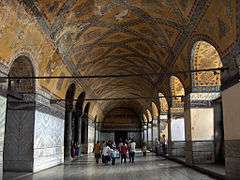
Upper gallery
The upper gallery, the matroneum, is laid out in a horseshoe shape that encloses the nave on three sides and is interrupted by the apse. Several mosaics are preserved in the upper gallery, an area traditionally reserved for the Empress and her court. The best-preserved mosaics are located in the southern part of the gallery.
The upper gallery contains runic graffiti presumed to be left by members of the Varangian Guard.
Throughout history the Hagia Sophia has been a victim to natural disasters, such as earthquakes, and has also fallen victim to vandalism. Structural damage can easily be seen on its exterior surface. To ensure that the Hagia Sophia did not sustain any damage on the interior of the building, studies have been conducted using ground penetrating radar within the gallery of the Hagia Sophia. With the use of GPR (ground penetrating radar), teams discovered weak zones within the Hagia Sophia's gallery and also concluded that the curvature of the vault dome has been shifted out of proportion, compared to its original angular orientation.[182]
.jpg)
Dome
The dome of Hagia Sophia has spurred particular interest for many art historians, architects and engineers because of the innovative way the original architects envisioned it. The dome is carried on four spherical triangular pendentives, one of the first large-scale uses of them. The pendentives are the corners of the square base of the dome, which curve upwards into the dome to support it, restraining the lateral forces of the dome and allowing its weight to flow downwards.[183][184] It was the largest pendentive dome in the world until the completion of St Peter's Basilica, and has a much lower height than any other dome of such a large diameter.
The great dome at the Hagia Sophia is one hundred and seven feet in diameter and is only two feet thick. The main building material for the Hagia Sophia composed of brick and mortar. Brick aggregate was used to make roofs easier to construct. The aggregate weighs one hundred and fifty pounds per cubic foot, an average weight of masonry construction at the time. Due to the materials plasticity it was chosen over cut stone due to the fact that aggregate can be used over a longer distance.[185] According to Rowland Mainstone, "it is unlikely that the vaulting-shell is anywhere more than one normal brick in thickness".[186]
The weight of the dome remained a problem for most of the building's existence. The original cupola collapsed entirely after the earthquake of 558; in 563 a new dome was built by Isidore the younger, a nephew of Isidore of Miletus. Unlike the original, this included 40 ribs and was raised 20 feet, in order to lower the lateral forces on the church walls. A larger section of the second dome collapsed as well, in two episodes, so that today only two sections of the present dome, in the north and south side, still date from the 562 reconstructions. Of the whole dome's 40 ribs, the surviving north section contains eight ribs, while the south section includes six ribs.[187]
Although this design stabilizes the dome and the surrounding walls and arches, the actual construction of the walls of Hagia Sophia weakened the overall structure. The bricklayers used more mortar than brick, which is more effective if the mortar was allowed to settle as the building would have been more flexible; however, the builders raced to complete the building and left no time for the mortar to cure before they began the next layer. When the dome was erected, its weight caused the walls to lean outward because of the wet mortar underneath. When Isidore the Younger rebuilt the fallen cupola, he had first to build up the interior of the walls to make them vertical again. Additionally, the architect raised the height of the rebuilt dome by approximately 6 metres (20 ft) so that the lateral forces would not be as strong and its weight would be transmitted more effectively down into the walls. Moreover, he shaped the new cupola like a scalloped shell or the inside of an umbrella, with ribs that extend from the top down to the base. These ribs allow the weight of the dome to flow between the windows, down the pendentives, and ultimately to the foundation.[188]
Hagia Sophia is famous for the light that reflects everywhere in the interior of the nave, giving the dome the appearance of hovering above. This effect was achieved by inserting forty windows around the base of the original structure. Moreover, the insertion of the windows in the dome structure reduced its weight.[188]
Buttresses
Numerous buttresses have been added throughout the centuries. The flying buttresses to the west of the building, although thought to have been constructed by the Crusaders upon their visit to Constantinople, are actually built during the Byzantine era. This shows that the Romans had prior knowledge of flying buttresses which can also be seen at in Greece, at the Rotunda of Galerius in Thessaloniki and at the monastery of Hosios Loukas in Boeotia, and in Italy at the octagonal basilica of San Vitale in Ravenna.[188] Other buttresses were constructed during the Ottoman times under the guidance of the architect Sinan. A total of 24 buttresses were added.[189]
Minarets
The minarets were an Ottoman addition and not part of the original church's Byzantine design. They were built for notification of invitations for prayers (adhan) and announcements. Mehmed had built a wooden minaret over one of the half domes soon after Hagia Sophia's conversion from a cathedral to a mosque. This minaret does not exist today. One of the minarets (at southeast) was built from red brick and can be dated back from the reign of Mehmed or his successor Beyazıd II. The other three were built from white limestone and sandstone, of which the slender northeast column was erected by Bayezid II and the two identical larger minarets to the west were erected by Selim II and designed by the famous Ottoman architect Mimar Sinan. Both are 60 metres (200 ft) in height, and their thick and massive patterns complete Hagia Sophia's main structure. Many ornaments and details were added to these minarets on repairs during the 15th, 16th, and 19th centuries, which reflect each period's characteristics and ideals.[190][191]
Notable elements and decorations
Originally, under Justinian's reign, the interior decorations consisted of abstract designs on marble slabs on the walls and floors, as well as mosaics on the curving vaults. Of these mosaics, one can still see the two archangels Gabriel and Michael in the spandrels (corners) of the bema. There were already a few figurative decorations, as attested by the late 6th-century ekphrasis of Paul the Silentiary, the Description of Hagia Sophia. The spandrels of the gallery are faced in inlaid thin slabs (opus sectile), showing patterns and figures of flowers and birds in precisely cut pieces of white marble set against a background of black marble. In later stages, figurative mosaics were added, which were destroyed during the iconoclastic controversy (726–843). Present mosaics are from the post-iconoclastic period.
Apart from the mosaics, many figurative decorations were added during the second half of the 9th century: an image of Christ in the central dome; Eastern Orthodox saints, prophets and Church Fathers in the tympana below; historical figures connected with this church, such as Patriarch Ignatius; and some scenes from the Gospels in the galleries.Basil II let artists paint on each of the four pendentives a giant six-winged seraph.[65] The Ottomans covered their faces with a golden star,[65] but in 2009 one of them was restored to the original state.[192]

Loggia of the Empress
The loggia of the empress is located in the centre of the gallery of the Hagia Sophia, above the Imperial Door and directly opposite the apse. From this matroneum (women's gallery), the empress and the court-ladies would watch the proceedings down below. A green stone disc of verd antique marks the spot where the throne of the empress stood.[193][194]
Lustration urns
Two huge marble lustration (ritual purification) urns were brought from Pergamon during the reign of Sultan Murad III. From the Hellenistic period, they are carved from single blocks of marble.[17]
Marble Door
The Marble Door inside the Hagia Sophia is located in the southern upper enclosure or gallery. It was used by the participants in synods, who entered and left the meeting chamber through this door. It is said that each side is symbolic and that one side represents heaven while the other represents hell. Its panels are covered in fruits and fish motives. The door opens into a space that was used as a venue for solemn meetings and important resolutions of patriarchate officials.[195]
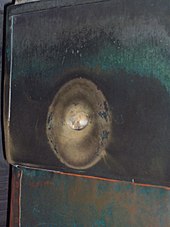
The Nice Door
The Nice Door is the oldest architectural element found in the Hagia Sophia dating back to the 2nd century BC. The decorations are of reliefs of geometric shapes as well as plants that are believed to have come from a pagan temple in Tarsus in Cilicia, part of the Cibyrrhaeot Theme in modern-day Mersin Province in southeastern Turkey. It was incorporated into the building by Emperor Theophilos in 838 where it is placed in the south exit in the inner narthex.[196]
Imperial Door
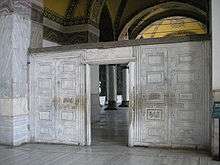
The Imperial Door is the door that would be used solely by the Emperor as well as his personal bodyguard and retinue. It is the largest door in the Hagia Sophia and has been dated to the 6th century. It is about 7 meters long and Byzantine sources say it was made with wood from Noah's Ark.[197]
Wishing column
At the northwest of the building, there is a column with a hole in the middle covered by bronze plates. This column goes by different names; the "perspiring" or "sweating column", the "crying column", or the "wishing column". The column is said to be damp when touched and have supernatural powers.[198] The legend states that since Gregory the Wonderworker appeared near the column in the year 1200, it has been moist. It is believed that touching the moisture cures many illnesses.[199][200]
Mosaics
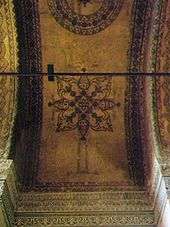
The first mosaics which adorned the church were completed during the reign of Justin II.[201] Many of the non-figurative mosaics in the church come from this period. Most of the mosaics, however, were created in the 10th and 12th centuries,[202] following the periods of Byzantine Iconoclasm.
During the Sack of Constantinople in 1204, the Latin Crusaders vandalized valuable items in every important Byzantine structure of the city, including the golden mosaics of the Hagia Sophia. Many of these items were shipped to Venice, whose Doge, Enrico Dandolo, had organized the invasion and sack of Constantinople after an agreement with Prince Alexios Angelos, the son of a deposed Byzantine emperor.
19th-century restoration
Following the building's conversion into a mosque in 1453, many of its mosaics were covered with plaster, due to Islam's ban on representational imagery. This process was not completed at once, and reports exist from the 17th century in which travellers note that they could still see Christian images in the former church. In 1847–1849, the building was restored by two Swiss-Italian Fossati brothers, Gaspare and Giuseppe, and Sultan Abdulmejid I allowed them to also document any mosaics they might discover during this process, which were later archived in Swiss libraries.[203] This work did not include repairing the mosaics and after recording the details about an image, the Fossatis painted it over again. The Fossatis restored the mosaics of the two hexapteryga (singular Greek: ἑξαπτέρυγον, pr. hexapterygon, six-winged angel; it is uncertain whether they are seraphim or cherubim) located on the two east pendentives, covering their faces again before the end of the restoration.[204] The other two placed on the west pendentives are copies in paint created by the Fossatis since they could find no surviving remains of them.[204] As in this case, the architects reproduced in paint damaged decorative mosaic patterns, sometimes redesigning them in the process. The Fossati records are the primary sources about a number of mosaic images now believed to have been completely or partially destroyed in the 1894 Istanbul earthquake. These include a mosaic over a now-unidentified Door of the Poor, a large image of a jewel-encrusted cross, and many images of angels, saints, patriarchs, and church fathers. Most of the missing images were located in the building's two tympana.
One mosaic they documented is Christ Pantocrator in a circle, which would indicate it to be a ceiling mosaic, possibly even of the main dome which was later covered and painted over with Islamic calligraphy that expounds God as the light of the universe. The Fossatis' drawings of the Hagia Sophia mosaics are today kept in the Archive of the Canton of Ticino.[205]
20th-century restoration
Many mosaics were uncovered in the 1930s by a team from the Byzantine Institute of America led by Thomas Whittemore. The team chose to let a number of simple cross images remain covered by plaster but uncovered all major mosaics found.
Because of its long history as both a church and a mosque, a particular challenge arises in the restoration process. Christian iconographic mosaics can be uncovered, but often at the expense of important and historic Islamic art. Restorers have attempted to maintain a balance between both Christian and Islamic cultures. In particular, much controversy rests upon whether the Islamic calligraphy on the dome of the cathedral should be removed, in order to permit the underlying Pantocrator mosaic of Christ as Master of the World, to be exhibited (assuming the mosaic still exists).[206]
The Hagia Sophia has been a victim to natural disasters that have caused deterioration to the buildings structure and walls. The deterioration of the Hagia Sophia's walls can be directly relate to salt crystallization. The crystallization of salt is due to an intrusion of rainwater that is at fault for the Hagia Sophia's deteriorating inner and outer walls. Diverting excess rainwater is the main solution to solve the deteriorating walls at the Hagia Sophia.[207]
Built between 532–537 a subsurface structure under the Hagia Sophia has been under investigation, using LaCoste-Romberg gravimeters to determine the depth of the subsurface structure and to discover other hidden cavities beneath the Hagia Sophia. The hidden cavities have also acted as a support system against earthquakes. With these findings using the LaCoste-Romberg gravimeters, it was also discovered that the Hagia Sophia's foundation is built on a slope of natural rock.[208]
Imperial Gate mosaic
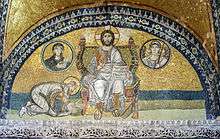
The Imperial Gate mosaic is located in the tympanum above that gate, which was used only by the emperors when entering the church. Based on style analysis, it has been dated to the late 9th or early 10th century. The emperor with a nimbus or halo could possibly represent emperor Leo VI the Wise or his son Constantine VII Porphyrogenitus bowing down before Christ Pantocrator, seated on a jewelled throne, giving his blessing and holding in his left hand an open book.[209] The text on the book reads: "Peace be with you" (John 20:19, 20:26) and "I am the light of the world" (John 8:12). On each side of Christ's shoulders is a circular medallion with busts: on his left the Archangel Gabriel, holding a staff, on his right his mother Mary.[210]
Southwestern entrance mosaic
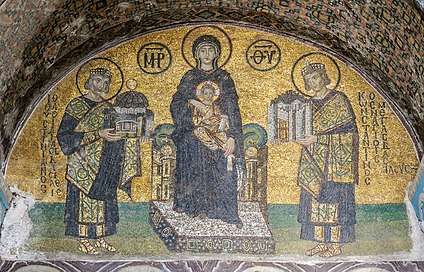
The southwestern entrance mosaic, situated in the tympanum of the southwestern entrance, dates from the reign of Basil II.[211] It was rediscovered during the restorations of 1849 by the Fossatis. The Virgin sits on a throne without a back, her feet resting on a pedestal, embellished with precious stones. The Christ Child sits on her lap, giving his blessing and holding a scroll in his left hand. On her left side stands emperor Constantine in ceremonial attire, presenting a model of the city to Mary. The inscription next to him says: "Great emperor Constantine of the Saints". On her right side stands emperor Justinian I, offering a model of the Hagia Sophia. The medallions on both sides of the Virgin's head carry the nomina sacra MP and ΘΥ, abbreviations of the Greek: Μήτηρ του Θεοῦ, romanized: Mētēr Theou, lit. 'Mother of God'.[212]
Apse mosaics
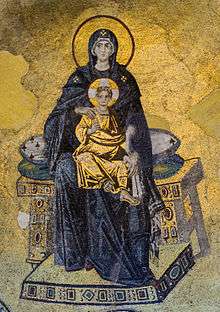
The Virgin and Child mosaic was the first of the post-iconoclastic mosaics. It was inaugurated on 29 March 867 by Patriarch Photius and the emperors Michael III and Basil I. This mosaic is situated in a high location on the half dome of the apse. Mary is sitting on a throne without a back, holding the Child Jesus on her lap. Her feet rest on a pedestal. Both the pedestal and the throne are adorned with precious stones. The portraits of the archangels Gabriel and Michael (largely destroyed) in the bema of the arch also date from the 9th century. The mosaics are set against the original golden background of the 6th century. These mosaics were believed to be a reconstruction of the mosaics of the 6th century that were previously destroyed during the iconoclastic era by the Byzantines of that time, as represented in the inaugural sermon by the patriarch Photios. However, no record of figurative decoration of Hagia Sophia exists before this time.[213]
Emperor Alexander mosaic
The Emperor Alexander mosaic is not easy to find for the first-time visitor, located on the second floor in a dark corner of the ceiling. It depicts the emperor Alexander in full regalia, holding a scroll in his right hand and a globus cruciger in his left. A drawing by the Fossatis showed that the mosaic survived until 1849 and that Thomas Whittemore, founder of the Byzantine Institute of America who was granted permission to preserve the mosaics, assumed that it had been destroyed in the earthquake of 1894. Eight years after his death, the mosaic was discovered in 1958 largely through the researches of Robert Van Nice. Unlike most of the other mosaics in Hagia Sophia, which had been covered over by ordinary plaster, the Alexander mosaic was simply painted over and reflected the surrounding mosaic patterns and thus was well hidden. It was duly cleaned by the Byzantine Institute's successor to Whittemore, Paul A. Underwood.[214][215]
Empress Zoe mosaic
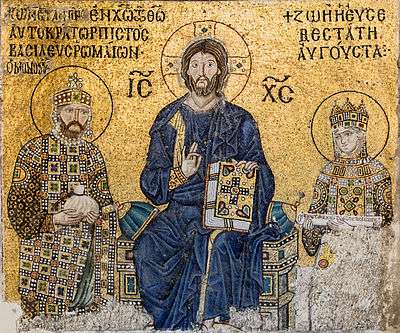
The Empress Zoe mosaic on the eastern wall of the southern gallery date from the 11th century. Christ Pantocrator, clad in the dark blue robe (as is the custom in Byzantine art), is seated in the middle against a golden background, giving his blessing with the right hand and holding the Bible in his left hand. On either side of his head are the nomina sacra IC and XC, meaning Iēsous Christos. He is flanked by Constantine IX Monomachus and Empress Zoe, both in ceremonial costumes. He is offering a purse, as a symbol of donation, he made to the church, while she is holding a scroll, symbol of the donations she made. The inscription over the head of the emperor says: "Constantine, pious emperor in Christ the God, king of the Romans, Monomachus". The inscription over the head of the empress reads as follows: "Zoë, the very pious Augusta". The previous heads have been scraped off and replaced by the three present ones. Perhaps the earlier mosaic showed her first husband Romanus III Argyrus or her second husband Michael IV. Another theory is that this mosaic was made for an earlier emperor and empress, with their heads changed into the present ones.[216]
Comnenus mosaic
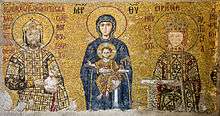
The Comnenus mosaic, also located on the eastern wall of the southern gallery, dates from 1122. The Virgin Mary is standing in the middle, depicted, as usual in Byzantine art, in a dark blue gown. She holds the Christ Child on her lap. He gives his blessing with his right hand while holding a scroll in his left hand. On her right side stands emperor John II Comnenus, represented in a garb embellished with precious stones. He holds a purse, symbol of an imperial donation to the church. his wife, the empress Irene of Hungary stands on the left side of the Virgin, wearing ceremonial garments and offering a document. Their eldest son Alexius Comnenus is represented on an adjacent pilaster. He is shown as a beardless youth, probably representing his appearance at his coronation aged seventeen. In this panel, one can already see a difference with the Empress Zoe mosaic that is one century older. There is a more realistic expression in the portraits instead of an idealized representation. The Empress Irene (born Piroska), daughter of Ladislaus I of Hungary, is shown with plaited blond hair, rosy cheeks, and grey eyes, revealing her Hungarian descent. The emperor is depicted in a dignified manner.[217]
Deësis mosaic
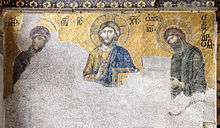
The Deësis mosaic (Δέησις, "Entreaty") probably dates from 1261. It was commissioned to mark the end of 57 years of Roman Catholic use and the return to the Eastern Orthodox faith. It is the third panel situated in the imperial enclosure of the upper galleries. It is widely considered the finest in Hagia Sophia, because of the softness of the features, the humane expressions and the tones of the mosaic. The style is close to that of the Italian painters of the late 13th or early 14th century, such as Duccio. In this panel the Virgin Mary and John the Baptist (Ioannes Prodromos), both shown in three-quarters profile, are imploring the intercession of Christ Pantocrator for humanity on Judgment Day. The bottom part of this mosaic is badly deteriorated.[218] This mosaic is considered as the beginning of a renaissance in Byzantine pictorial art.[219]
Northern tympanum mosaics
The northern tympanum mosaics feature various saints. They have been able to survive due to their high and inaccessible location. They depict Patriarchs of Constantinople John Chrysostom and Ignatius standing, clothed in white robes with crosses, and holding richly jewelled Bibles. The figures of each patriarch, revered as saints, are identifiable by labels in Greek. The other mosaics in the other tympana have not survived probably due to the frequent earthquakes, as opposed to any deliberate destruction by the Ottoman conquerors.[220]
Dome mosaic
The dome was decorated with four non-identical figures of the six-winged angels which protect the Throne of God; it is uncertain whether they are seraphim or cherubim. The mosaics survive in the eastern part of the dome, but since the ones on the western side were damaged during the Byzantine period, they have been renewed as frescoes. During the Ottoman period each seraph's (or cherub's) face was covered with metallic lids in the shape of stars, but these were removed to reveal the faces during renovations in 2009.[221]
Other burials
- Mustafa I, in the courtyard
- Enrico Dandolo, in the east gallery
Gallery
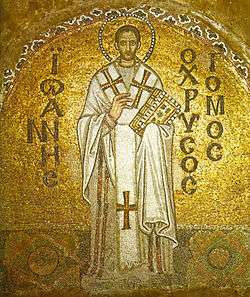 Mosaic in the northern tympanum depicting Saint John Chrysostom
Mosaic in the northern tympanum depicting Saint John Chrysostom- Six patriarchs mosaic in the southern tympanum as drawn by the Fossati brothers
- Moasics as drawn by the Fossati brothers
 Interior of the Hagia Sophia by John Singer Sargent, 1891
Interior of the Hagia Sophia by John Singer Sargent, 1891 Photograph by Sébah & Joaillier, c.1900–10
Photograph by Sébah & Joaillier, c.1900–10.jpg) Watercolour of the interior by Philippe Chaperon, 1893
Watercolour of the interior by Philippe Chaperon, 1893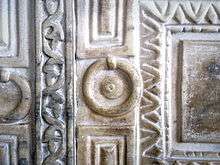 Detail of relief on the Marble Door.
Detail of relief on the Marble Door..jpg) Imperial Gate from the nave
Imperial Gate from the nave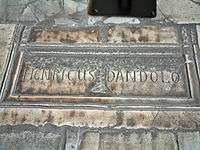 19th-century centotaph of Enrico Dandolo, Doge of Venice, and commander of the 1204 Sack of Constantinople
19th-century centotaph of Enrico Dandolo, Doge of Venice, and commander of the 1204 Sack of Constantinople.jpg) Ambigram ΝΙΨΟΝΑΝΟΜΗΜΑΤΑΜΗΜΟΝΑΝΟΨΙΝ ("Wash your sins, not only the face") inscribed upon a holy water font
Ambigram ΝΙΨΟΝΑΝΟΜΗΜΑΤΑΜΗΜΟΝΑΝΟΨΙΝ ("Wash your sins, not only the face") inscribed upon a holy water font Gate of the külliye, by John Frederick Lewis, 1838
Gate of the külliye, by John Frederick Lewis, 1838_Serai_-_Lewis_John_F_-_1838.jpg) Fountain of Ahmed III from the gate of the külliye, by John Frederick Lewis, 1838
Fountain of Ahmed III from the gate of the külliye, by John Frederick Lewis, 1838_-_Lewis_John_F_-_1838.jpg) Southern side of Hagia Sophia, looking east, by John Frederick Lewis, 1838
Southern side of Hagia Sophia, looking east, by John Frederick Lewis, 1838 From Verhandeling van de godsdienst der Mahometaanen, by Adriaan Reland, 1719
From Verhandeling van de godsdienst der Mahometaanen, by Adriaan Reland, 1719.jpg) Hagia Sophia from the south-west, 1914
Hagia Sophia from the south-west, 1914.jpg) Hagia Sophia in the snow, December 2015
Hagia Sophia in the snow, December 2015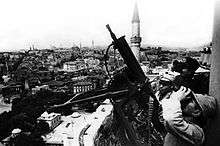 Maschinengewehr 08 mounted on a minaret during World War II
Maschinengewehr 08 mounted on a minaret during World War II
Works modelled on the Hagia Sophia
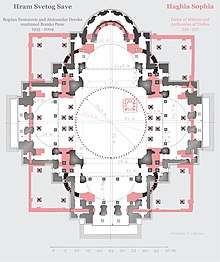
Many religious buildings have been modeled on the Hagia Sophia's core structure of a large central dome resting on pendentives and buttressed by two semi-domes.
Many Byzantine churches were modeled on the Hagia Sophia including the namesake Hagia Sophia in Thessaloniki, Greece. Under Justinian, the Hagia Irene was remodeled to have a dome similar to the Hagia Sophia. St Mark's Basilica in Venice most likely influence on its architecture and design is the Hagia Sophia.[222]
Several mosques commissioned by the Ottoman dynasty closely mimic the geometry of the Hagia Sophia, including the Süleymaniye Mosque and the Bayezid II Mosque. In many cases, Ottoman architects preferred to surround the central dome with four semi-domes rather than two.[223] This is true in the Sultan Ahmed Mosque, the New Mosque (Istanbul), and the Fatih Mosque. Like the original plan of the Hagia Sophia, many of these mosques are also entered through a colonnaded courtyard. However, the courtyard of the Hagia Sophia no longer exists.
Neo-Byzantine churches modeled on the Hagia Sophia include the Kronstadt Naval Cathedral and Poti Cathedral which closely replicate the internal geometry of the Hagia Sophia. The interior of the Kronstadt Naval Cathedral is a nearly 1-to-1 copy of the Hagia Sophia. The marble revetment also closely mimics the source work. Like Ottoman mosques, many churches based on the Hagia Sophia include four semi-domes rather than two, such as the Church of Saint Sava in Belgrade.
Several churches combine the layout of the Hagia Sophia with a Latin cross plan. For instance, the Cathedral Basilica of Saint Louis (St. Louis), where the transept is formed by two semi-domes surrounding the main dome. This church also closely emulates the column capitals and mosaic styles of the Hagia Sophia. Other similar examples include the Alexander Nevsky Cathedral, Sofia, St Sophia's Cathedral, London, Saint Clement Catholic Church, Chicago, and Basilica of the National Shrine of the Immaculate Conception.
The Catedral Metropolitana Ortodoxa in São Paulo and the Église du Saint-Esprit (Paris) closely follow the interior layout of the Hagia Sophia. Both include four semi-domes, but the two lateral semi-domes are very shallow. In terms of size, the Église du Saint-Esprit is about two-thirds the scale of the Hagia Sophia.
Synagogues based on the Hagia Sophia include the Congregation Emanu-El (San Francisco), Great Synagogue of Florence, and Hurva Synagogue.
References
Notes
- Also translated: "I think of Hagia Sophia and I am very saddened."[153]
Citations
- Curta, Florin; Holt, Andrew (2016). Great Events in Religion: An Encyclopedia of Pivotal Events in Religious History [3 volumes]. ABC-CLIO. p. 299. ISBN 978-1-61069-566-4.
Hagia Sophia was consecrated on December 27, 537, five years after construction had begun. The church was dedicated to the Wisdom of God, referring to the Logos (the second entity of the Holy Trinity) or, alternatively, Christ as the Logos incarnate.
- "Kültür ve Turizm Bakanlığı, Ayasofya'yı 'müze' olarak kendisinden alıp 'cami' olarak Diyanet'e bağlayan kararı böyle duyurdu". 10 July 2020.
- Hamm, Jean S. (2010). Term Paper Resource Guide to Medieval History. ABC-CLIO. p. 39. ISBN 978-0-313-35967-5.
Hagia Sophia, or the Church of Holy Wisdom, is one of the world's most spectacular churches, representing not only great beauty, but also masterful engineering.
- Fazio, Michael; Moffett, Marian; Wodehouse, Lawrence (2009). Buildings Across Time (3rd ed.). McGraw-Hill Higher Education. ISBN 978-0-07-305304-2.
- Simons, Marlise (22 August 1993). "Center of Ottoman Power". The New York Times. Retrieved 4 June 2009.
- Kleiner, Fred S.; Christin J. Mamiya (2008). Gardner's Art Through the Ages: Volume I, Chapters 1–18 (12th ed.). Mason, OH: Wadsworth. p. 329. ISBN 978-0-495-46740-3.
- Heinle & Schlaich 1996
- Cameron 2009.
- Meyendorff 1982.
- Meyendorff 1982.
- Janin (1953), p. 471.
- Binns, John (2002). An Introduction to the Christian Orthodox Churches. Cambridge University Press. p. 57. ISBN 978-0-521-66738-8.
- McKenzie, Steven L.; Graham, Matt Patrick (1998). The Hebrew Bible Today: An Introduction to Critical Issues. Westminster John Knox Press. p. 149. ISBN 978-0-664-25652-4.
- Müller-Wiener (1977), p. 112.
- March 2013, Owen Jarus-Live Science Contributor 01. "Hagia Sophia: Facts, History & Architecture". livescience.com. Retrieved 15 July 2020.
- "Hagia Sophia Archived 5 January 2009 at the Wayback Machine." ArchNet.
- Müller-Wiener (1977), p. 91.
- Magdalino, Paul, et al. "Istanbul: Buildings, Hagia Sophia" in Grove Art Online. Oxford Art Online. accessed 28 February 2010.
- "Hagia Sophia still Istanbul's top tourist attraction". hurriyet.
- "Hagia Sophia: Turkey turns iconic Istanbul museum into mosque". BBC News. 10 July 2020. Retrieved 11 July 2020.
President Erdogan stressed that the country had exercised its sovereign right in converting it back to a mosque. He told a press conference the first Muslim prayers would be held inside the building on 24 July.
- "Hagia Sophia still top tourist attraction". hurriyet.
- "Presidential Decree on the opening of Hagia Sophia to worship promulgated on the Official Gazette". Presidency of the Republic of Turkey: Directorate of Communications. 10 July 2020. Retrieved 17 July 2020.
- Gall, Carlotta (10 July 2020). "Erdogan Signs Decree Allowing Hagia Sophia to Be Used as a Mosque Again". The New York Times.
- Dal, Aylin; Karadag, Kemal (10 July 2020). "Turkey: Court strikes down Hagia Sophia museum decree". Anadolu Agency. Retrieved 17 July 2020.
- "Turkey's Erdogan says Hagia Sophia becomes mosque after court ruling". CNBC. 10 July 2020. Retrieved 24 July 2020.
- "Turning Hagia Sophia into museum violated will of its endower, Mehmed the Conquerer, Turkish court says". Daily Sabah. 11 July 2020. Retrieved 17 July 2020.
- "Turkey's president formally makes Hagia Sophia a mosque". AP NEWS. 10 July 2020. Retrieved 17 July 2020.
- "UNESCO statement on Hagia Sophia, Istanbul". UNESCO. 10 July 2020. Retrieved 11 July 2020.
- "Church body wants Hagia Sophia decision reversed". BBC News. 11 July 2020. Retrieved 13 July 2020.
- "Pope 'pained' by Hagia Sophia mosque decision". BBC News. 12 July 2020. Retrieved 13 July 2020.
- "World reacts to Turkey reconverting Hagia Sophia into a mosque". Al Jazeera. 10 July 2020. Retrieved 10 July 2020.
- "Byzantine News, Issue 33, July 2020". us17.campaign-archive.com. Retrieved 25 July 2020.
- Müller-Wiener (1977), p. 84.
- Alessandro E. Foni; George Papagiannakis; Nadia Magnentat-Thalmann. "Virtual Hagia Sophia: Restitution, Visualization and Virtual Life Simulation" (PDF). Archived from the original (PDF) on 9 July 2007. Retrieved 3 July 2007.
- Janin (1953), p. 472.
- Dark, Ken R.; Kostenec, Jan (2019). Hagia Sophia in Context: An Archaeological Re-examination of the Cathedral of Byzantine Constantinople. Oxford: Oxbow Books. pp. 11–12. ISBN 978-1-78925-030-5.
- Mainstone, Rowland J. (1997) [1988]. Hagia Sophia: Architecture, Structure and Liturgy of Justinian's Great Church. London: Thames and Hudson. p. 131. ISBN 978-0-500-27945-8.
- Patria of Constantinople
- Mainstone, Rowland J. (1997) [1988]. Hagia Sophia: Architecture, Structure and Liturgy of Justinian's Great Church. London: Thames and Hudson. p. 132. ISBN 978-0-500-27945-8.
- Mainstone, Rowland J. (1997) [1988]. Hagia Sophia: Architecture, Structure and Liturgy of Justinian's Great Church. London: Thames and Hudson. p. 137. ISBN 978-0-500-27945-8.
- Dark, Ken R.; Kostenec, Jan (2019). Hagia Sophia in Context: An Archaeological Re-examination of the Cathedral of Byzantine Constantinople. Oxford: Oxbow Books. pp. 12–15. ISBN 978-1-78925-030-5.
- "Hagia Sophia". Encyclopædia Britannica.
The original church on the site of the Hagia Sophia is said to have been ordered to be built by Constantine I in 325 on the foundations of a pagan temple.
- Ljudmila Djukic. "Hagia Sophia (Constantinople)". The Byzantine Empire: A Historical Encyclopedia. 2. ABC-CLIO. p. 195.
- Sharon La Boda. International Dictionary of Historic Places: Southern Europe. Taylor & Francis. p. 343.
- Lucien Ellington. Eastern Europe: An Introduction to the People, Lands, and Culture, Volume 1. p. 853.
- Dark, Ken R.; Kostenec, Jan (2019). Hagia Sophia in Context: An Archaeological Re-examination of the Cathedral of Byzantine Constantinople. Oxford: Oxbow Books. pp. 15–20. ISBN 978-1-78925-030-5.
- Mainstone, Rowland J. (1997) [1988]. Hagia Sophia: Architecture, Structure and Liturgy of Justinian's Great Church. London: Thames and Hudson. p. 135. ISBN 978-0-500-27945-8.
- "Book I (beginning)". The Buildings of Procopius. Loeb Classical Library. 1940. Retrieved 15 July 2020.
- Kaldellis, Anthony (2013). "The Making of Hagia Sophia and the Last Pagans of New Rome". Journal of Late Antiquity. 6 (2): 347–366. doi:10.1353/jla.2013.0019. ISSN 1942-1273.
- John Lydus, De Magistratibus reipublicae Romanae III.76
- Evagrius Scholasticus, Historia Ecclesiastica IV.30
- Dark, Ken R.; Kostenec, Jan (2019). Hagia Sophia in Context: An Archaeological Re-examination of the Cathedral of Byzantine Constantinople. Oxford: Oxbow Books. p. 46. ISBN 978-1-78925-030-5.
- Krautheimer, Richard (1986). Early Christian and Byzantine Architecture (4th ed.). New Haven and London: Yale University Press/Pelican History of Art. p. 205. ISBN 978-0-300-05296-1.
- Mango, Cyril (1985). Byzantine Architecture (1st ed.). New York: Electa/Rizzoli. p. 65. ISBN 978-0-8478-0615-7.
- Müller-Wiener (1977), p. 86.
- "The Chronicle of John Malalas," Bk 18.86 Translated by E. Jeffreys, M. Jeffreys, and R. Scott. Australian Association of Byzantine Studies, 1986 vol 4.
- "The Chronicle of Theophones Confessor: Byzantine and Near Eastern History AD 284–813." Translated with commentary by Cyril Mango and Roger Scott. AM 6030 p. 316, with this note: Theophanes' precise date should be accepted.
- Janin, Raymond (1950). Constantinople Byzantine (in French) (1 ed.). Paris: Institut Français d'Etudes Byzantines. p. 41.
- "Haghia Sophia". Istanbul /: Emporis. Retrieved 4 December 2011.
- "Baalbek keeps its secrets". stoneworld.
- Silentiarius, Paulus (2011). Descriptio Sanctae Sophiae. Descriptio Ambonis. Berlin: De Gruyter. doi:10.1515/9783110239072. ISBN 978-3-11-023907-2.
- Bell, Peter Neville, ed. (2009). Three political voices from the age of Justinian: Agapetus, 'Advice to the Emperor'; Dialogue on political science; Paul the Silentiary: 'Description of Hagia Sophia'. Liverpool: Liverpool University Press. ISBN 978-1-84631-209-0. OCLC 318874086.
- Maranci, Christina (September 2003). "The Architect Trdat: Building Practices and Cross-Cultural Exchange in Byzantium and Armenia". Journal of the Society of Architectural Historians. 62 (3): 294–305. doi:10.2307/3592516. JSTOR 3592516.
- Müller-Wiener (1977), p. 87.
- Mamboury (1953) p. 287
- Magdalino, Paul (2016). "The triumph of 1133". In Bucossi, Alessandra; Suarez, Alex Rodriguez (eds.). John II Komnenos, Emperor of Byzantium: In the Shadow of Father and Son. Centre for Hellenic Studies, King's College London Publications 17. Oxford: Routledge. pp. 53–70. doi:10.4324/9781315590547. ISBN 978-1-315-59054-7.
- Niketas Choniates, Annals, XIX. O City of Byzantium: Annals of Niketas Choniatēs. Translated by Magoulias, Harry J. Wayne State University Press. 1984. p. 12. ISBN 978-0-8143-1764-8.
- Niketas Choniates, Annals, CLVII–CLVIII. O City of Byzantium: Annals of Niketas Choniatēs. Translated by Magoulias, Harry J. Wayne State University Press. 1984. pp. 89–90 & 382, notes 434–435. ISBN 978-0-8143-1764-8.
- Niketas Choniates, Annals, CCXXX–CCXLII. O City of Byzantium: Annals of Niketas Choniatēs. Translated by Magoulias, Harry J. Wayne State University Press. 1984. pp. 129–136. ISBN 978-0-8143-1764-8.
- Niketas Choniates, Annals, CCXXX–CCXLII. O City of Byzantium: Annals of Niketas Choniatēs. Translated by Magoulias, Harry J. Wayne State University Press. 1984. pp. 129–136. ISBN 978-0-8143-1764-8.
- Niketas Choniates, Annals, CCLI–CCLII. O City of Byzantium: Annals of Niketas Choniatēs. Translated by Magoulias, Harry J. Wayne State University Press. 1984. pp. xx–xxi, 141. ISBN 978-0-8143-1764-8.
- O City of Byzantium: Annals of Niketas Choniatēs. Translated by Magoulias, Harry J. Wayne State University Press. 1984. p. 315. ISBN 978-0-8143-1764-8.
- O City of Byzantium: Annals of Niketas Choniatēs. Translated by Magoulias, Harry J. Wayne State University Press. 1984. p. 306. ISBN 978-0-8143-1764-8.
- Victor Roudometof. Globalization and Orthodox Christianity: The Transformations of a Religious Tradition. Routledge. p. 47.
- Avner Falk. Franks and Saracens: Reality and Fantasy in the Crusades. Routledge. p. 164.
- Hamblin, William J. (2008). "Arab perspectives on the Fourth Crusade". In Madden, Thomas F. (ed.). The Fourth Crusade: Event, Aftermath, and Perceptions : Papers from the Sixth Conference of the Society for the Study of the Crusades and the Latin East , Istanbul, Turkey, 25-29 August 2004. Society for the Study of the Crusades and the Latin East. Aldershot: Ashgate Publishing, Ltd. p. 175. ISBN 978-0-7546-6319-5.
- A. Edward Siecienski. Orthodox Christianity: A Very Short Introduction. Oxford University Press. p. 24.
- Gallo, Rudolfo (1927). "La tomba di Enrico Dandolo in Santa Sofia a Constantinople". Rivista Mensile della Citta di Venezia. 6: 270–83.
- Philippides, Marios; Hanak, Walter K. (2001). The Siege and the Fall of Constantinople in 1453: Historiography, Topography, and Military Studies. Farnham: Ashgate Publishing, Ltd. p. 228. ISBN 978-1-4094-1064-5.
- Philippides, Marios; Hanak, Walter K. (2011). The Siege and the Fall of Constantinople in 1453: Historiography, Topography, and Military Studies. Farnham: Ashgate Publishing, Ltd. pp. 222–223. ISBN 978-1-4094-1064-5.
- Contested Spaces, Common Ground: Space and Power Structures in Contemporary Multireligious Societies. BRILL. 27 October 2016. ISBN 978-90-04-32580-7.
- Runciman, Steven (1965). The Fall of Constantinople 1453. Cambridge University Press. pp. 145–148. ISBN 978-0-521-39832-9.
- Nicol, Donald MacGillivray (1979). The End of the Byzantine Empire. London: Edward Arnold. p. 88. ISBN 978-0-7131-6250-9.
- "Fall of Constantinople". Encyclopædia Britannica.
- Inalcik, Halil (1969). "The Policy of Mehmed II toward the Greek Population of Istanbul and the Byzantine Buildings of the City". Dumbarton Oaks Papers. 23/24: 229–249. doi:10.2307/1291293. ISSN 0070-7546.
- Nicol. The End of the Byzantine Empire, p. 90.
- Runciman, Steven (1965). The Fall of Constantinople 1453. Cambridge University Press. p. 147. ISBN 978-0-521-39832-9.
- Runciman. The Fall of Constantinople, pp. 133–34.
- Nicol, Donald M. The Last Centuries of Byzantium 1261–1453. Cambridge: Cambridge University Press, 1972, p. 389.
- Runciman, Steven (1965). The Fall of Constantinople 1453. Cambridge University Press. p. 147. ISBN 978-0-521-39832-9.
- Runciman, Steven (1965). The Fall of Constantinople 1453. Cambridge University Press. p. 149. ISBN 978-0-521-39832-9.
- Barry, Fabio (2007). "Walking on Water: Cosmic Floors in Antiquity and the Middle Ages". The Art Bulletin. 89 (4): 627–656. ISSN 0004-3079.
- Tafur, Pero (1926). Travels and Adventures, 1435–1439. Trans. M. Letts. London: G. Routledge. pp. 138–48.
- G. Gerola, "Le vedute di Costantinopoli di Cristoforo Buondemonti," SBN 3 (1931): 247–79.
- Mamboury (1953), p. 288.
- Necipoĝlu (2005), p. 13
- Boyar & Fleet (2010), p. 145
- Gökovali, Şadan. Istanbul. Istanbul: Ticaret Matbaacilik T.A.Ş. pp. 22–23.
- Mungan, I. (2004). Hagia Sophia and Mimar Sinan. Mungan & Wittek (eds); Taylor & Francis Group, London. pp. 383–84. ISBN 978-90-5809-642-5.
- Müller-Wiener (1977), p. 93.
- Turkish Cultural Foundation. "The Fossati brothers". www.turkishculture.org. Retrieved 26 July 2020.
- Grove Encyclopedia of Islamic Art & Architecture: Istanbul, Oxford University Press, p. 324.
- Pedone, Silvia (2011). "The Marble Omphalos of Saint Sophia in Constantinople. An Analysis of an Opus Sectile Pavement of Middle Byzantine Age". In Şahin, Mustafa (ed.). 11th International Colloquium on Ancient Mosaics, October 16th-20th, 2009, Bursa, Turkey: Mosaics of Turkey and parallel developments in the rest of the ancient and medieval world: questions of iconography, style and technique from the beginnings of mosaic until the late Byzantine era. İstanbul: Uludağ Üniversitesi, Mozaik Araştırmaları Uygulama ve Araştırma Merkezi. pp. 749–768. ISBN 978-605-5607-81-4. OCLC 801099151.
- "Hagia Sophia". World Monuments Fund. Retrieved 4 December 2011.
- "Top 10: Turkey's most visited museums". Hürriyet Daily News. 10 November 2014.
- "Ýstanbul Tanýtýmý – Ayasofya Müzesi". Istanbul. Archived from the original on 24 January 2012. Retrieved 4 December 2011.
- "Ayasofya'nın 4 minaresinden 5 vakit ezan sesi yükseliyor: Ayasofya Müzesi'nin ibadete açık olan bölümü Hünkar Kasrı'na, Diyanet İşleri Başkanlığı tarafından uzun yıllardan sonra ilk kez asaleten imam atandı" (in Turkish). Anadolu Agency. 20 October 2016.
- "Ayasofya'da her ezan okuduğunda ilk günkü heyecanı yaşıyor: Büyük Ayasofya Camisi İmam Hatibi Kurra Hafız Önder Soy, Ayasofya'da 4 yıldır ilk günkü heyecanıyla görevini yapıyor" (in Turkish). Anadolu Agency. 11 June 2020.
- "Group unveils initiative on Hagia Sophia". Homeboy Media News. 16 June 2007.
- Международная группа активистов продолжает возвращения Церкви константинопольского собора Святой Софии Православие.Ru 26 июля 2007.
- Константинопольская София – мать всех церквей) Православие.Ru, 29 October 2007.
- "Call to reinstate Hagia Sophia as mosque". Financial Times. 15 November 2013. Retrieved 24 December 2013.
- "Greece angered over Turkish Deputy PM's Hagia Sophia remarks". Hürriyet. 19 November 2013. Retrieved 20 November 2013.
- "Turkey: Pressure mounts for Hagia Sophia to be converted into mosque". Christian Today. 13 December 2013. Retrieved 24 December 2013.
- "Pope's remarks 'to accelerate Hagia Sophia's conversion into mosque'". Hürriyet Daily News. 16 April 2015.
- "First call to prayer inside Istanbul's Hagia Sophia in 85 years". Hürriyet.
- "Turkish politics heats up over Hagia Sophia". hurriyetdailynews. 12 June 2020.
- "Court declares Hagia Sophia a 'monument museum'". hurriyetdailynews. 22 November 2016.
- "Hagia Sophia imam: part of Erdogan's Islamization drive?". Deutsche Welle. 7 November 2016.
- "Muslim group prays in front of Hagia Sophia to demand re-conversion into mosque". Hürriyet.
- "Turkey rejects Greek criticism of Hagia Sophia prayers". Hürriyet.
- Gall, Carlotta (10 July 2020). "Turkish Court Clears Way for Hagia Sophia to Be Used as a Mosque Again". The New York Times. Retrieved 10 July 2020.
- Turkish President Erdoğan recites Islamic prayer at the Hagia Sophia Hürriyet.
- "Hagia Sophia's status to be changed to mosque: Erdoğan". Hürriyet.
- "Hagia Sophia: Controversy as Erdogan says museum and former cathedral will become a mosque". Euronews.
- "UNESCO "halts" Erdogan's plans to turn the Hagia Sophia into Mosque". Daily Hellas. 27 March 2019. Retrieved 10 April 2019.
- "Milli Gazete | Erdoğan Administration Takes Control Of Istanbul's Historic Topkapı Palace". en.milligazete.com.tr. Retrieved 2 August 2020.
- "Erdoğan administration takes control of Istanbul's historic Topkapı Palace". Ahval. Retrieved 2 August 2020.
- Erdoğan, Recep Tayyip (6 September 2019). "Presidential Decree" (PDF). Resmî Gazete (in Turkish).
- "Turkey goes back to the future as Hagia Sophia set for Islamic prayers". Middle East Eye. Retrieved 11 July 2020.
- "Turkey refutes Greece on Quran session in Hagia Sophia - Turkey News". Hürriyet Daily News. Retrieved 11 July 2020.
- "Making the Hagia Sophia a mosque is a political slap in the face for the West". The Telegraph. Retrieved 7 July 2020.
- https://www.aa.com.tr/tr/turkiye/ayasofyayi-camiden-muzeye-donusturen-bakanlar-kurulu-kararina-iptal-/1906077
- "Turkey turns iconic Istanbul museum into mosque". BBC News. 10 July 2020. Retrieved 11 July 2020.
- Avundukluoğlu, Muhammet Emin (11 July 2020). "'Hagia Sophia decision ends our nation's longing'". Anadolu Agency. Retrieved 17 July 2020.
- "Hagia Sophia converted into mosque as Erdoğan signs decree". hurriyetdailynews. 10 July 2020. Retrieved 10 July 2020.
- "Hagia Sophia icons to be preserved: Presidential spokesperson". hurriyetdailynews. 12 July 2020. Retrieved 12 July 2020.
- "İnsanlık mirasına dair kararlar iktidarın politik oyunlarına göre alınamaz" [Decisions on human heritage cannot be made on the basis of political games played by the government]. www.hdp.org.tr (in Turkish). Retrieved 12 July 2020.
- "Istanbul mayor supports Hagia Sophia conversion move, 'as long as it benefits Turkey'". hurriyetdailynews. 13 July 2020. Retrieved 13 July 2020.
- "Hagia Sophia opens to Muslims for Friday prayers". BBC News. 24 July 2020. Retrieved 24 July 2020.
- "First Friday prayers at Hagia Sophia for 86 years". BBC News. 24 July 2020. Retrieved 25 July 2020.
- Cagatay Zontur, Erdogan (17 July 2020). "Hagia Sophia a matter of Turkey's sovereignty: Erdogan". Anadolu Agency.
- "Erdoğan invites Pope Francis to the inauguration of Hagia Sophia Mosque". romereports. 22 July 2020. Retrieved 22 July 2020.
- "Turkey invites foreign leaders for prayers at Hagia Sophia". hurriyetdailynews. 21 July 2020. Retrieved 21 July 2020.
- "July 24: From Lausanne to Hagia Sophia Mosque, a date for Turkey's sovereignty". Daily Sabah. 10 July 2020. Retrieved 24 July 2020.
- Gall, Carlotta (15 July 2020). "Erdogan Signs Decree Allowing Hagia Sophia to Be Used as a Mosque Again". The New York Times. Retrieved 17 July 2020.
- "Ecumenical Patriarch Bartholomew about Hagia Sophia". www.ecupatria.org/. 30 June 2020.
- "Orthodox Patriarch says turning Istanbul's Hagia Sophia into mosque would be divisive". Reuters. 30 June 2020.
- "Заявление Патриарха Московского и всея Руси Кирилла в связи с ситуацией относительно Святой Софии". www.patriarchia.ru (in Russian). 6 July 2020.
- "Russian church leader says calls to turn Hagia Sophia into mosque threaten Christianity". Reuters. 6 July 2020.
- "WCC letter to President Erdogan to keep Hagia Sophia as the shared heritage of humanity". www.oikoumene.org. 11 July 2020. Retrieved 25 July 2020.
- "World Council of Churches "dismayed" at Hagia Sophia shift". AP News. 11 July 2020. Retrieved 17 July 2020.
- "Pope Francis: 'I think of Hagia Sophia, and I am very saddened'". www.vaticannews.va. 12 July 2020. Retrieved 25 July 2020.
- "Papa: "Penso a Santa Sofia e sono molto addolorato"" (in Italian). LaPresse. Retrieved 26 July 2020.
- "Turkey: Statement by the High Representative/Vice-President Josep Borrell on the decision regarding Hagia Sophia". EEAS - European External Action Service - European Commission. Retrieved 17 July 2020.
- Stearns, Jonathan (13 July 2020). "EU Urges Turkey to 'Reverse' Hagia Sophia Reconversion Plan". Bloomberg. Retrieved 17 July 2020.
- Casert, Raf; Fraser, Suzan; Gatopoulos, Derek (13 July 2020). "EU, Turkey clash over Hagia Sophia, Mediterranean drilling". AP NEWS. Retrieved 17 July 2020.
- "Greece pushes for sanctions against Turkey, but EU insists on dialogue". EURACTIV. 13 July 2020. Retrieved 17 July 2020.
- Kucukgocmen, Ali; Butler, Daren (13 July 2020). "Turkey will cover Hagia Sophia mosaics during prayers - ruling party spokesman". Reuters. Retrieved 17 July 2020.
- Firat, Esat (13 July 2020). "Israeli group burns Turkish flag over Hagia Sophia move". Anadolu Agency. Retrieved 17 July 2020.
- Cagatay Zontur, Erdogan (14 July 2020). "Turkey condemns burning of Turkish flag in E.Jerusalem". Anadolu Agency. Retrieved 17 July 2020.
- Aytekin, Emre (11 July 2020). "Northern Cyprus content with Hagia Sophia decision". Anadolu Agency. Retrieved 17 July 2020.
- Kursun, Muhammet; Salari, Elaheh (13 July 2020). "Iran praises Turkey's reopening of Hagia Sophia mosque". Anadolu Agency. Retrieved 17 July 2020.
- Teslova, Elena (13 July 2020). "Russia: Hagia Sophia status 'Turkey's internal affair'". Anadolu Agency.
- Yusuf, Ahmed; Asmar, Ahmed (13 July 2020). "Arabs hail Turkey's reopening of Hagia Sophia mosque". Anadolu Agency. Retrieved 17 July 2020.
- Yildiz, Hamdi (11 July 2020). "Hamas movement supports Hagia Sophia decision". Anadolu Agency. Retrieved 17 July 2020.
- Latif, Aamir (11 July 2020). "Pakistani lawmaker hails Turkey's Hagia Sophia move". Anadolu Agency. Retrieved 17 July 2020.
- Kavak, Gokhan (13 July 2020). "South African Muslims hail Turkey's Hagia Sophia move". Anadolu Agency. Retrieved 17 July 2020.
- Erdem, Omer (11 July 2020). "Mauritania rejoices opening of Hagia Sophia as mosque". Anadolu Agency. Retrieved 17 July 2020.
- https://english.alaraby.co.uk/english/news/2020/7/18/turkeys-hagia-sophia-mosque-conversion-forbidden-egypt-mufti
- Kara Aydin, Havva (11 July 2020). "Turkish spokesman: Hagia Sophia icons to be preserved". Anadolu Agency. Retrieved 17 July 2020.
- Kucukgocmen, Ali; Butler, Daren (13 July 2020). "Turkey will inform UNESCO about Hagia Sophia moves - minister". Reuters. Retrieved 17 July 2020.
- Kambas, Michele (14 July 2020). "Greece says Turkey is being 'petty' over Hagia Sophia". Reuters. Retrieved 17 July 2020.
- Koutantou, Angeliki; Maltezou, Renee; Kambas, Michele (10 July 2020). "Greece condemns Turkey's decision to convert Hagia Sophia into mosque". Reuters. Retrieved 17 July 2020.
- Melton, J. Gordon; Baumann, Martin (2010). Religions of the World: A Comprehensive Encyclopedia of Beliefs and Practices. ABC-CLIO. p. 513.
- Syrmakezis, K.; Mavrouli, O.; Papaevaggeliou, P.; Aggelakopolulou, E.; Bakolas, A.; Moropoulou, A. (November 2013). "Finite element analysis and fragility curves for the evaluation of restoration mortars behavior regarding the earthquake protection of historic structures". Soil Dynamics and Earthquake Engineering. 54: 61–65. doi:10.1016/j.soildyn.2013.07.002. ISSN 0267-7261.
- "Helge Svenshon 2010: Das Bauwerk als »Aistheton Soma« - Eine Neuinterpretation der Hagia Sophia im Spiegel antiker Vermessungslehre und angewandter Mathematik. In: Falko Daim · Jörg Drauschke (Hrsg.) Byzanz – das Römerreich im Mittelalter Teil 2, 1 Schauplätze, Römisch-Germanisches Zentralmuseum Forschungsinstitut für Vor- und Frühgeschichte" (PDF). Retrieved 15 July 2020.
- Svenshon, Helge Olaf: Heron of Alexandria and the Dome of Hagia Sophia in Istanbul. In: Proceedings of the Third Congress on Construction History. Brandenburg University of Technology Cottbus, 20th – 24th May 2009. NEUNPLUS1, Berlin, S. 1387-1394. ISBN 978-3-936033-31-1
- Stiftung, Gerda Henkel. "Die Hagia Sophia Justinians – Mathematischer Raum als Bühne des Kaisers". L.I.S.A. WISSENSCHAFTSPORTAL GERDA HENKEL STIFTUNG.
- Dark, Ken R.; Kostenec, Jan (2019). Hagia Sophia in Context: An Archaeological Re-examination of the Cathedral of Byzantine Constantinople. Oxford: Oxbow Books. pp. 69–72. ISBN 978-1-78925-030-5.
- Majeska, George P. (1978). "Notes on the Archeology of St. Sophia at Constantinople: The Green Marble Bands on the Floor". Dumbarton Oaks Papers. 32: 299–308. doi:10.2307/1291426. ISSN 0070-7546.
- Yalçıner, Cahit Çağlar; Kurban, Yunus Can; Altunel, Erhan (May 2017). "Research using GPR into the cause of cracks and depressions in the floor of the gallery of Hagia Sophia Museum". Construction and Building Materials. 139: 458–66. doi:10.1016/j.conbuildmat.2017.02.036. ISSN 0950-0618.
- Kleiner and Mamiya. Gardner's Art Through the Ages, p. 331.
- "pendentive (architecture) – Britannica Online Encyclopedia". Britannica.com. Retrieved 4 December 2011.
- MacDonald, William (1957). "Design and Technology in Hagia Sophia". Perspecta. 4: 20–27. doi:10.2307/1566853. ISSN 0079-0958. JSTOR 1566853.
- Mainstone, Rowland J. (1997). Hagia Sophia: Architecture, Structure, and Liturgy of Justinian's Great Church. Thames and Hudson. p. 81. ISBN 978-0-500-27945-8.
- Mainstone, Rowland J. (2001). Hagia Sophia. London: Thames & Hudson. pp. 90–93. ISBN 978-0-500-27945-8.
- Mainstone, R.J. (Rowland J.) (1988). Hagia Sophia : architecture, structure, and liturgy of Justinian's great church. New York: Thames and Hudson. ISBN 978-0500340981. OCLC 15378795.
- "Buttresses | Hagia Sophia Museum". ayasofyamuzesi.gov.tr. Directorate of Hagia Sophia Museum. Retrieved 18 April 2017.
- Hagia Sophia. "Mosque". Archived from the original on 28 January 2013. Retrieved 26 February 2013.
- "Minarets | Hagia Sophia Museum".
- Ronchey (2010), p. 157
- "Hagia Sophia: Facts, History & Architecture". Live Science. Retrieved 12 June 2017.
- Istanbul City Guide (English). ASBOOK. 2009.
- "The Marble Door." The Marble Door | Hagia Sophia Museum, ayasofyamuzesi.gov.tr/en/door-marble-door.
- "The Nice Door." The nice door, Hagia Sophia Museum
- "The Emperor Door." The Emperor Door, Hagia Sophia Museum
- "Ayasofya Müzesi". Ayasofyamuzesi.gov.tr. Archived from the original on 4 November 2013. Retrieved 3 November 2013.
- "Aya Sofya or Hagia Sophia Mosque-Church and Museum". Very Turkey.
- "The Architectural Review". Architectural Press Limited. 15 July 1905. Retrieved 15 July 2020 – via Google Books.
- N., Patricios, Nicholas (27 March 2014). The sacred architecture of Byzantium : art, liturgy and symbolism in early Christian churches. London. ISBN 978-1780762913. OCLC 879616183.
- Gökovali, Şadan. Istanbul. Istanbul: Ticaret Matbaacilik T.A.Ş. p. 27.
- "Hagia Sophia. Nova PBS program; originally aired 2/25/2015". Retrieved 15 July 2020.
- Hoffman (1999), p. 207
- "Monuments éternels". Programmes ARTE. 21 September 2014. Archived from the original on 5 May 2015.
- The Hagia Sophia Archived 4 October 2018 at the Wayback Machine – by Mount Holyoke College
- Mizutani, Etsuko; Ogura, Daisuke; Ishizaki, Takeshi; Abuku, Masaru; Sasaki, Juni (1 November 2015). "Influence of the Infiltrated Rainwater on the Degradation of the Inner Wall in Hagia Sophia, Istanbul". Energy Procedia. 78: 1353–58. doi:10.1016/j.egypro.2015.11.153. ISSN 1876-6102.
- Friedrich, Jürgen; Gerstenecker, Carl; Gürkan, Onur (October 1996). "Gravimetric examination of Hagia Sophia's subsurface structure". Journal of Geodesy. 70 (10): 645–51. Bibcode:1996JGeod..70..645F. doi:10.1007/bf00868226. ISSN 0949-7714.
- "The Hagia Sophia Church". Guideistanbul.net. Retrieved 4 December 2011.
- Hagia Sophia. "Imperial Door Mosaic". hagiasophia.com. Archived from the original on 7 January 2019. Retrieved 27 January 2019.
- Lorenzo Riccardi, Observations on Basil II as Patron of the Arts, in Actual Problems of Theory and History of Art, I, Collection of articles. Materials of the Conference of Young Specialists (St. Petersburg State University, 1–5 December 2010), St. Petersburg 2011 (ISBN 978-5-288-05174-6), pp. 39–45; Lorenzo Riccardi, Alcune riflessioni sul mosaico del vestibolo sud-ovest della Santa Sofia di Costantinopoli, in Vie per Bisanzio. VIII Congresso Nazionale dell'Associazione Italiana di Studi Bizantini (Venezia 25–28 novembre 2009), a cura di Antonio Rigo, Andrea Babuin e Michele Trizio, Bari, Edizioni di Pagina 2012 (ISBN 978-88-7470-229-9), pp. 357–71.
- Hagia Sophia. "Southwestern Vestibule". hagiasophia.com. Archived from the original on 20 December 2018. Retrieved 27 January 2019.
- Hagia Sophia. "Apse Mosaic". hagiasophia.com. Archived from the original on 20 December 2018. Retrieved 27 January 2019.
- Lord Kinross. "Hagia Sophia: A History of Constantinople." Newsweek, 1972, pp. 132–33.
- Hagia Sophia. "Emperor Alexander". hagiasophia.com. Archived from the original on 20 December 2018. Retrieved 27 January 2019.
- Hagia Sophia. "Empress Zoe". hagiasophia.com. Archived from the original on 20 December 2018. Retrieved 27 January 2019.
- Hagia Sophia. "Comnenus". hagiasophia.com. Archived from the original on 20 December 2018. Retrieved 27 January 2019.
- Parry, K., The Blackwell Companion to Eastern Christianity, John Wiley & Sons, 2010. p. 379.
- Hagia Sophia. "Deesis". hagiasophia.com. Archived from the original on 20 December 2018. Retrieved 27 January 2019.
- Hagia Sophia. "North Tympanum". hagiasophia.com. Archived from the original on 20 December 2018. Retrieved 27 January 2019.
- "Dome Angel Figures". Hagia Sophia Museum.
- "Basilica di San Marco". www.genegillminiatures.com. Retrieved 29 July 2020.
- Martin, Charles (1930). "Hagia Sophia and the Great Imperial Mosques". The Art Bulletin. 12 (4): 321. Retrieved 16 July 2020.
Bibliography
- Boyran, Ebru; Fleet, Kate (2010). A social History of Ottoman Istanbul. Cambridge: Cambridge University Press. ISBN 978-0-521-19955-1.
- Brubaker, Leslie; Haldon, John (2011). Byzantium in the Iconoclast era (ca 680–850). Cambridge: Cambridge University Press. ISBN 978-0-521-43093-7.
- Hagia Sophia. Hagia Sophia. Accessed 23 September 2014.
- Hoffman, Volker (1999). Die Hagia Sophia in Istanbul (in German). Bern: Lang. ISBN 978-3-906762-81-4.
- Janin, Raymond (1953). La Géographie Ecclésiastique de l'Empire Byzantin. 1. Part: Le Siège de Constantinople et le Patriarcat Oecuménique. 3rd Vol. : Les Églises et les Monastères. Paris: Institut Français d'Etudes Byzantines.
- Mainstone, Rowland J. (1997). Hagia Sophia: Architecture, Structure, and Liturgy of Justinian's Great Church (reprint edition). W.W. Norton & Co. ISBN 978-0-500-27945-8..
- Mamboury, Ernest (1953). The Tourists' Istanbul. Istanbul: Çituri Biraderler Basımevi.
- Müller-Wiener, Wolfgang (1977). Bildlexikon zur Topographie Istanbuls: Byzantion, Konstantinupolis, Istanbul bis zum Beginn d. 17 Jh (in German). Tübingen: Wasmuth. ISBN 978-3-8030-1022-3.
- Necipoĝlu, Gulru (2005). The Age of Sinan: Architectural Culture in the Ottoman Empire. London: Reaktion Books. ISBN 978-1-86189-244-7.
- Ronchey, Silvia; Braccini, Tommaso (2010). Il romanzo di Costantinopoli. Guida letteraria alla Roma d'Oriente (in Italian). Torino: Einaudi. ISBN 978-88-06-18921-1.
- Runciman, Steven (1965). The Fall of Constantinople, 1453. Cambridge: Cambridge University Press. p. 145. ISBN 0-521-39832-0.
- Savignac, David. "The Medieval Russian Account of the Fourth Crusade – A New Annotated Translation".
- Turner, J. (1996). Grove Dictionary of Art. Oxford: Oxford University Press. ISBN 978-0-19-517068-9.
Further reading
- Alchermes, Joseph D. (2005). "Art and Architecture in the Age of Justinian". In Maas, Michael (ed.). The Cambridge Companion to the Age of Justinian. Cambridge: Cambridge U.P. pp. 343–75. ISBN 978-0-521-52071-3.
- Balfour, John Patrick Douglas (1972). Hagia Sophia. W.W. Norton & Company. ISBN 978-0-88225-014-4.
- Cimok, Fatih (2004). Hagia Sophia. Milet Publishing Ltd. ISBN 978-975-7199-61-8.
- Doumato, Lamia (1980). The Byzantine church of Hagia Sophia: Selected references. Vance Bibliographies. ASIN B0006E2O2M.
- Goriansky, Lev Vladimir (1933). Haghia Sophia: analysis of the architecture, art and spirit behind the shrine in Constantinople dedicated to Hagia Sophia. American School of Philosophy. ASIN B0008C47EA.
- Harris, Jonathan, Constantinople: Capital of Byzantium. Hambledon/Continuum (2007). ISBN 978-1-84725-179-4
- Howland Swift, Emerson (1937). The bronze doors of the gate of the horologium at Hagia Sophia. University of Chicago. ASIN B000889GIG.
- Kahler, Heinz (1967). Haghia Sophia. Praeger. ASIN B0008C47EA.
- Kinross, Lord (1972). Hagia Sophia, Wonders of Man. Newsweek. ASIN B000K5QN9W.
- Kleinbauer, W. Eugene; Anthony White (2007). Hagia Sophia. London: Scala Publishers. ISBN 978-1-85759-308-2.
- Kleinbauer, W. Eugene (2000). Saint Sophia at Constantinople: Singulariter in Mundo (Monograph (Frederic Lindley Morgan Chair of Architectural Design), No. 5.). William L. Bauhan. ISBN 978-0-87233-123-5.
- Krautheimer, Richard (1984). Early Christian and Byzantine Architecture. New Haven, CT: Yale University Press. ISBN 978-0-300-05294-7.
- Mainstone, R.J. (1997). Hagia Sophia: Architecture, Structure, and Liturgy of Justinian's Great Church. London: Thames & Hudson. ISBN 978-0-500-27945-8.
- Mainstone, Rowland J. (1988). Hagia Sophia. Architecture, structure and liturgy of Justinian's great church. London: Thames & Hudson. ISBN 978-0-500-34098-1.
- Mango, Cyril; Ahmed Ertuğ (1997). Hagia Sophia. A vision for empires. Istanbul.
- Mark, R.; Çakmaktitle, AS. (1992). Hagia Sophia from the Age of Justinian to the Present. Princeton Architectural. ISBN 978-1-878271-11-2.
- Nelson, Robert S. (2004). Hagia Sophia, 1850–1950: Holy Wisdom Modern Monument. Chicago: University of Chicago Press. ISBN 978-0-226-57171-3.
- Özkul, T.A. (2007). Structural characteristics of Hagia Sophia: I-A finite element formulation for static analysis. Elsevier.
- Scharf, Joachim:Der Kaiser in Proskynese. Bemerkungen zur Deutung des Kaisermosaiks im Narthex der Hagia Sophia von Konstantinopel. In: Festschrift Percy Ernst Schramm zu seinem siebzigsten Geburtstag von Schülern und Freunden zugeeignet, Wiesbaden 1964, S. 27–35.
- Swainson, Harold (2005). The Church of Sancta Sophia Constantinople: A Study of Byzantine Building. Boston, MA: Adamant Media Corporation. ISBN 978-1-4021-8345-4.
- Weitzmann, Kurt, ed., Age of spirituality: late antique and early Christian art, third to seventh century, no. 592, 1979, Metropolitan Museum of Art, New York, ISBN 978-0-87099-179-0
- Xydis, Stephen G. (1947). "The Chancel Barrier, Solea, and Ambo of Hagia Sophia". The Art Bulletin. 29 (1): 1–24. doi:10.2307/3047098. ISSN 0004-3079.
- Yucel, Erdem (2005). Hagia Sophia. Scala Publishers. ISBN 978-1-85759-250-4.
Articles
- Atchison, Bob (2020). "History of Hagia Sophia - the Church of Holy Wisdom". My World of Byzantium.
- Bordewich, Fergus M., "A Monumental Struggle to Preserve Hagia Sophia", Smithsonian magazine, December 2008
- Osseman, Dick. "Aya Sofya Photo Gallery". Pbase.com.
Mosaics
- Hagia Sophia, hagiasophia.com: Mosaics.
- MacDonald, William Lloyd (1951). The uncovering of Byzantine mosaics in Hagia Sophia. Archaeological Institute of America. ASIN B0007GZTKS.
- Mango, Cyril (1972). The mosaics of St. Sophia at Istanbul: The church fathers in the north Tympanum. Dumbarton Oaks Center for Byzantine Studies. ASIN B0007CAVA0.
- Mango, Cyril (1968). The Apse mosaics of St. Sophia at Istanbul: Report on work carried out in 1964. Johnson Reprints. ASIN B0007G5RBY.
- Mango, Cyril; Heinz Kahler (1967). Hagia Sophia: With a Chapter on the Mosaics. Praeger. ASIN B0000CO5IL.
- Teteriatnikov, Natalia B. (1998). Mosaics of Hagia Sophia, Istanbul: The Fossati Restoration and the Work of the Byzantine Institute. Dumbarton Oaks Research Library and Collection. ISBN 978-0-88402-264-0.
- Riccardi, Lorenzo (2012). Alcune riflessioni sul mosaico del vestibolo sud-ovest della Santa Sofia di Costantinopoli, in Vie per Bisanzio. VIII Congresso Nazionale dell'Associazione Italiana di Studi Bizantini (Venezia 25–28 novembre 2009), a cura di Antonio Rigo, Andrea Babuin e Michele Trizio. Bari. pp. 357–71. ISBN 978-88-7470-229-9.
- Yücel, Erdem (1988). The mosaics of Hagia Sophia. Efe Turizm. ASIN B0007CBGYA.
External links
| External image | |
|---|---|
| Wikimedia Commons has media related to: |
| Wikisource has the text of a 1905 New International Encyclopedia article about Hagia Sophia. |
- Official website (in Turkish)
- 360 Degree Virtual Tour of Hagia Sophia Mosque Museum
- Gigapixel of Hagia Sophia Dome ( 214 Billion Pixel )
- Hagia Sophia Museum, Republic of Turkey, Ministry of Culture & Tourism
- The Most Visited Museums of Turkey: Hagia Sophia Museum, Governorship of Istanbul
- Hagia Sophia Mosque, Istanbul Directorate of Culture & Tourism
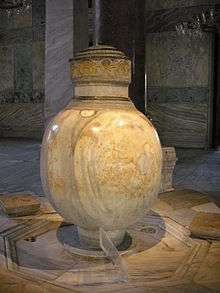


.jpg)